- Privacy Policy

Home » How To Write A Research Proposal – Step-by-Step [Template]

How To Write A Research Proposal – Step-by-Step [Template]
Table of Contents

How To Write a Research Proposal
Writing a Research proposal involves several steps to ensure a well-structured and comprehensive document. Here is an explanation of each step:
1. Title and Abstract
- Choose a concise and descriptive title that reflects the essence of your research.
- Write an abstract summarizing your research question, objectives, methodology, and expected outcomes. It should provide a brief overview of your proposal.
2. Introduction:
- Provide an introduction to your research topic, highlighting its significance and relevance.
- Clearly state the research problem or question you aim to address.
- Discuss the background and context of the study, including previous research in the field.
3. Research Objectives
- Outline the specific objectives or aims of your research. These objectives should be clear, achievable, and aligned with the research problem.
4. Literature Review:
- Conduct a comprehensive review of relevant literature and studies related to your research topic.
- Summarize key findings, identify gaps, and highlight how your research will contribute to the existing knowledge.
5. Methodology:
- Describe the research design and methodology you plan to employ to address your research objectives.
- Explain the data collection methods, instruments, and analysis techniques you will use.
- Justify why the chosen methods are appropriate and suitable for your research.
6. Timeline:
- Create a timeline or schedule that outlines the major milestones and activities of your research project.
- Break down the research process into smaller tasks and estimate the time required for each task.
7. Resources:
- Identify the resources needed for your research, such as access to specific databases, equipment, or funding.
- Explain how you will acquire or utilize these resources to carry out your research effectively.
8. Ethical Considerations:
- Discuss any ethical issues that may arise during your research and explain how you plan to address them.
- If your research involves human subjects, explain how you will ensure their informed consent and privacy.
9. Expected Outcomes and Significance:
- Clearly state the expected outcomes or results of your research.
- Highlight the potential impact and significance of your research in advancing knowledge or addressing practical issues.
10. References:
- Provide a list of all the references cited in your proposal, following a consistent citation style (e.g., APA, MLA).
11. Appendices:
- Include any additional supporting materials, such as survey questionnaires, interview guides, or data analysis plans.
Research Proposal Format
The format of a research proposal may vary depending on the specific requirements of the institution or funding agency. However, the following is a commonly used format for a research proposal:
1. Title Page:
- Include the title of your research proposal, your name, your affiliation or institution, and the date.
2. Abstract:
- Provide a brief summary of your research proposal, highlighting the research problem, objectives, methodology, and expected outcomes.
3. Introduction:
- Introduce the research topic and provide background information.
- State the research problem or question you aim to address.
- Explain the significance and relevance of the research.
- Review relevant literature and studies related to your research topic.
- Summarize key findings and identify gaps in the existing knowledge.
- Explain how your research will contribute to filling those gaps.
5. Research Objectives:
- Clearly state the specific objectives or aims of your research.
- Ensure that the objectives are clear, focused, and aligned with the research problem.
6. Methodology:
- Describe the research design and methodology you plan to use.
- Explain the data collection methods, instruments, and analysis techniques.
- Justify why the chosen methods are appropriate for your research.
7. Timeline:
8. Resources:
- Explain how you will acquire or utilize these resources effectively.
9. Ethical Considerations:
- If applicable, explain how you will ensure informed consent and protect the privacy of research participants.
10. Expected Outcomes and Significance:
11. References:
12. Appendices:
Research Proposal Template
Here’s a template for a research proposal:
1. Introduction:
2. Literature Review:
3. Research Objectives:
4. Methodology:
5. Timeline:
6. Resources:
7. Ethical Considerations:
8. Expected Outcomes and Significance:
9. References:
10. Appendices:
Research Proposal Sample
Title: The Impact of Online Education on Student Learning Outcomes: A Comparative Study
1. Introduction
Online education has gained significant prominence in recent years, especially due to the COVID-19 pandemic. This research proposal aims to investigate the impact of online education on student learning outcomes by comparing them with traditional face-to-face instruction. The study will explore various aspects of online education, such as instructional methods, student engagement, and academic performance, to provide insights into the effectiveness of online learning.
2. Objectives
The main objectives of this research are as follows:
- To compare student learning outcomes between online and traditional face-to-face education.
- To examine the factors influencing student engagement in online learning environments.
- To assess the effectiveness of different instructional methods employed in online education.
- To identify challenges and opportunities associated with online education and suggest recommendations for improvement.
3. Methodology
3.1 Study Design
This research will utilize a mixed-methods approach to gather both quantitative and qualitative data. The study will include the following components:
3.2 Participants
The research will involve undergraduate students from two universities, one offering online education and the other providing face-to-face instruction. A total of 500 students (250 from each university) will be selected randomly to participate in the study.
3.3 Data Collection
The research will employ the following data collection methods:
- Quantitative: Pre- and post-assessments will be conducted to measure students’ learning outcomes. Data on student demographics and academic performance will also be collected from university records.
- Qualitative: Focus group discussions and individual interviews will be conducted with students to gather their perceptions and experiences regarding online education.
3.4 Data Analysis
Quantitative data will be analyzed using statistical software, employing descriptive statistics, t-tests, and regression analysis. Qualitative data will be transcribed, coded, and analyzed thematically to identify recurring patterns and themes.
4. Ethical Considerations
The study will adhere to ethical guidelines, ensuring the privacy and confidentiality of participants. Informed consent will be obtained, and participants will have the right to withdraw from the study at any time.
5. Significance and Expected Outcomes
This research will contribute to the existing literature by providing empirical evidence on the impact of online education on student learning outcomes. The findings will help educational institutions and policymakers make informed decisions about incorporating online learning methods and improving the quality of online education. Moreover, the study will identify potential challenges and opportunities related to online education and offer recommendations for enhancing student engagement and overall learning outcomes.
6. Timeline
The proposed research will be conducted over a period of 12 months, including data collection, analysis, and report writing.
The estimated budget for this research includes expenses related to data collection, software licenses, participant compensation, and research assistance. A detailed budget breakdown will be provided in the final research plan.
8. Conclusion
This research proposal aims to investigate the impact of online education on student learning outcomes through a comparative study with traditional face-to-face instruction. By exploring various dimensions of online education, this research will provide valuable insights into the effectiveness and challenges associated with online learning. The findings will contribute to the ongoing discourse on educational practices and help shape future strategies for maximizing student learning outcomes in online education settings.
About the author
Muhammad Hassan
Researcher, Academic Writer, Web developer
You may also like

How To Write A Proposal – Step By Step Guide...

Grant Proposal – Example, Template and Guide

How To Write A Business Proposal – Step-by-Step...

Business Proposal – Templates, Examples and Guide

Proposal – Types, Examples, and Writing Guide

How to choose an Appropriate Method for Research?
The Edvocate
- Lynch Educational Consulting
- Dr. Lynch’s Personal Website
- Write For Us
- The Tech Edvocate Product Guide
- The Edvocate Podcast
- Terms and Conditions
- Privacy Policy
- Assistive Technology
- Best PreK-12 Schools in America
- Child Development
- Classroom Management
- Early Childhood
- EdTech & Innovation
- Education Leadership
- First Year Teachers
- Gifted and Talented Education
- Special Education
- Parental Involvement
- Policy & Reform
- Best Colleges and Universities
- Best College and University Programs
- HBCU’s
- Higher Education EdTech
- Higher Education
- International Education
- The Awards Process
- Finalists and Winners of The 2022 Tech Edvocate Awards
- Finalists and Winners of The 2021 Tech Edvocate Awards
- Finalists and Winners of The 2020 Tech Edvocate Awards
- Finalists and Winners of The 2019 Tech Edvocate Awards
- Finalists and Winners of The 2018 Tech Edvocate Awards
- Finalists and Winners of The 2017 Tech Edvocate Awards
- Award Seals
- GPA Calculator for College
- GPA Calculator for High School
- Cumulative GPA Calculator
- Grade Calculator
- Weighted Grade Calculator
- Final Grade Calculator
- The Tech Edvocate
- AI Powered Personal Tutor
College Minor: Everything You Need to Know
14 fascinating teacher interview questions for principals, tips for success if you have a master’s degree and can’t find a job, 14 ways young teachers can get that professional look, which teacher supplies are worth the splurge, 8 business books every teacher should read, conditional admission: everything you need to know, college majors: everything you need to know, 7 things principals can do to make a teacher observation valuable, 3 easy teacher outfits to tackle parent-teacher conferences, how to write a research proposal.

As a professor of education, one of my favorite courses to teach was “Introduction to Education Research.” The primary purpose of this course is to introduce students to the concepts and methods of education research. The emphasis is placed on methods most frequently encountered in social science research, especially in the field of education. Students are expected complete a research proposal during this course, and in the follow-up course, “Applications of Education Research,” they use this proposal to conduct a research study.
Why did I love teaching this course? Because education research is not an easy skill to develop, but with hard work and dedication it can be mastered. When I was able to help someone who hated statistics learn to love statistics, it gave me a sense of accomplishment. In this piece, I plan to take you through the process of developing an education research proposal that you can be proud of.
Let’s start off by discussing research problems and questions and then moving on to the four main parts of a research proposal.
Research Problem and Question(s)
A research question is the core of a research project, study, or review of the literature. It centers the study, sets the methodology, and guides all stages of inquiry, analysis, and reporting.
A research question starts with a research problem, an issue that you would like to know more about or change. Research problems can be:
- Areas of concern
- Conditions that need to be changed
- Difficulties that should be erased
- Questions that need to be answered
A research problem leads to a research question that:
- Is worth investigating
- Contributes knowledge & value to the field
- Improves educational practice
- Improves humanity
The key features of a good research question:
- The question is viable.
- The question has clarity.
- The question has gravitas.
- The question is moral.
How to Get From Research Problem to Research Questions and Purpose
The following section was originally published on a site entitled Research Rundowns :
Step 1. Draft a research question/hypothesis.
Example : What effects did 9/11/01 have on the future plans of students who were high school seniors at the time of the terrorist attacks?
Example (measurable) Questions: Did seniors consider enlisting in the military as a result of the attacks? Did seniors consider colleges closer to home as a result?
Step 2. Draft a purpose statement.
Example: The purpose of this study is to determine the effects of the 9/11/01 tragedy on the future plans of high school seniors.
Step 3. Revise and rewrite the research question/hypothesis.
Example : What is the association between 9/11/01 and future plans of high school seniors?
Step 4. Revise and rewrite the research question/hypothesis.
Example : Purpose Statement (Declarative): The purpose of this study is to explore the association between 9/11/01 and future plans of high school seniors.
Note: Both are neutral; they do not presume an association, either negative or positive.
Parts of a Research Proposal
A research proposal includes four sections, and they are as follows:
Section One: Introduction
Section Two: Review of the Literature
Section Three: Research Methodology
Section Four: References
The information that follows offers step by step instructions on how to complete each section of your proposal.
Part #1: Write a paragraph that introduces your topic. Mention your topic in the first sentence. What are you planning to study? What is the purpose of the study?
Part #2: Fully discuss your topic. What specifically interests you? Think of a specific research question (or questions) and state it clearly and precisely. You can also begin to formulate your ideas on how you might study your research question, though you need not be very specific in this section. For example, if you plan to study attitudes toward school vouchers, suggest what characteristics influence how individuals feel about school vouchers (e.g., income, location, etc.).
Part #3: Explain to the reader why it is important to study your topic and put it into a larger educational context. Here is where you answer the “So what?” question. That is, you plan to study XYZ. So what? Why is it important to study this topic? What is the educational importance of this research? Why is this study significant? This is your opportunity to be broad, general, and theoretical in your thinking.
This section should be at least 3-5 pages. Based on the outline provided above, you must utilize sub-headings within this section. You must cite articles within this section to support your topic and claim.
The purpose of this section is to find and summarize qualitative or quantitative research studies that directly relate to your research question(s). Use library databases to start searching for articles, but employ other resources when necessary.
When looking for articles, you need to adhere to the following guidelines:
- Use scholarly journals rather than popular magazines, newspaper articles, or the internet.
- Rely on the educational literature. If you are unsure whether an article or journal is included in the discipline, ask me.
- In general, select recent articles (i.e., 1960 or later). However, if an article was written in 1952, for example, is extremely pertinent to your proposal, then use it.
- Choose only research articles (qualitative or quantitative research) for the literature review. Do not include theoretical works, editorials, book reviews, program reports, etc. If you are unsure about an article, I will gladly take a look at it. Your literature review should not be more than 15 pages.
Your task is to:
- Briefly, restate your research topic in an opening paragraph. Provide a short introduction about what question(s) you are trying to answer, why this is educationally interesting, and why you chose it. Also, provide a brief overview of the topics you will cover in your literature review.
- Divide the literature that you have into sections of like Then, for each section, write an essay summarizing the studies. Be sure to state the research purpose, method(s), and findings ONLY for the studies that are paramount to your study. [NOTE: Use transitions within your essay so that it flows and does not appear like disjointed blocks of information.]
- Write a concluding paragraph that summarizes the articles. For example, how will these articles inform your research?
- DO NOT PLAGIARIZE.
The purpose of this section is to allow you to explain your research methodology. This can be the hardest part of the proposal for some students; therefore, do not wait until the last minute to write this section. Think about your design when you write your literature review.
- In a brief introduction, restate your research problem(s)/question(s).
- Indicate the following parts of your research methodology:
- Describe your vehicle of observation. How do you plan to collect your data? If you are creating a survey, what kinds of questions do you plan to ask? If you are going to do interviews, what will you ask of your interviewees?
- What population do you plan to use? How do you plan to sample this population?
- How will you select your sample? What kind of sampling method will you use?
- How will you analyze your data? What kind of analysis best fits your project, and why?
- If you plan to conduct qualitative research, discuss the following issues (be as detailed and accurate as possible):
- Define the theoretical constructs will you be using.
- What is the main concept you are investigating? What other concepts will be examined (note the concepts’ potential structures, processes, causes, and consequences)?
- What type(s) of qualitative analysis will you conduct?
- If you plan to conduct quantitative research, discuss the following issues (be as detailed and specific as possible):
- Clearly, state your hypotheses.
- Identify and operationalize your variables. List the independent variables and the dependent variable.
- List the pros and cons of your methodology.
- Write a concluding paragraph that summarizes the research design and proposal. When writing this section, imagine that have enough resources for your research design. Since you will not perform the research be creative, but appropriate, with your design.
On the last section of your proposal, include an APA-formatted bibliography of the articles, books, websites, etc. that you refer to in the text. This page should be titled “References.” The references should be listed alphabetically by the last name of the first author. As a rule of thumb, you need an average of 4 references per page. For instance, if your proposal is ten pages, then technically need 40 references. However, this does not necessarily to have four references on each page.
Please carefully note the following issues:
The entire proposal should be no more than 40 pages excluding the title page and the “References” section. Any page(s) over the 40th page will not be read. All of the parts must be typed, double-spaced, in a 12-point font, with 1-inch margins on all four sides of each page.
If you followed the outline and instructions that we have provided, we are confident that you have completed a top-notch research proposal.
What Education Leaders Look for in Edtech ...
Creating a culture of inclusion in the ....
Matthew Lynch
Related articles more from author.

Does Class Size Really Matter?

When do children show evidence of self-esteem? Earlier than you might think
These 3 studies on education results may shock you.

How to Gain Leadership Skills in College

Off Campus Student: Tips to Handle Life in a New City

Everything You Need to Know About the Civil Service Exam
What’s Included: Research Proposal Template
Our free dissertation/thesis proposal template covers the core essential ingredients for a strong research proposal. It includes clear explanations of what you need to address in each section, as well as straightforward examples and links to further resources.
The research proposal template covers the following core elements:
- Introduction & background (including the research problem)
- Literature review
- Research design / methodology
- Project plan , resource requirements and risk management
The cleanly-formatted Google Doc can be downloaded as a fully editable MS Word Document (DOCX format), so you can use it as-is or convert it to LaTeX.
PS – if you’d like a high-level template for the entire thesis, you can we’ve got that too .
Research Proposal Template FAQS
What types of research proposals can this template be used for.
The proposal template follows the standard format for academic research projects, which means it will be suitable for the vast majority of dissertations and theses (especially those within the sciences), whether they are qualitative or quantitative in terms of design.
Keep in mind that the exact requirements for the introduction chapter/section will vary between universities and degree programs. These are typically minor, but it’s always a good idea to double-check your university’s requirements before you finalise your structure.
Is this template for an undergrad, Master or PhD-level proposal?
This template can be used for a research project at any level of study. Doctoral-level projects typically require the research proposal to be more extensive/comprehensive, but the structure will typically remain the same.
How long should my research proposal be?
The length of a research proposal varies by institution and subject, but as a ballpark, it’s usually between 1,500 and 3,000 words.
To be safe, it’s best to check with your university if they have any preferences or requirements in terms of minimum and maximum word count for the research propsal.
How detailed should the methodology of the proposal be?
You don’t need to go into the fine details of your methodology, but this section should be detailed enough to demonstrate that your research approach is feasible and will address your research questions effectively. Be sure to include your intended methods for data collection and analysis.
Can I include preliminary data or pilot study results in my proposal?
Generally, yes. This can strengthen your proposal by demonstrating the feasibility of your research. However, make sure that your pilot study is approved by your university before collecting any data.
Can I share this template with my friends/colleagues?
Yes, you’re welcome to share this template in its original format (no editing allowed). If you want to post about it on your blog or social media, we kindly request that you reference this page as your source.
What format is the template (DOC, PDF, PPT, etc.)?
The research proposal template is provided as a Google Doc. You can download it in MS Word format or make a copy to your Google Drive. You’re also welcome to convert it to whatever format works best for you, such as LaTeX or PDF.
Do you have templates for the other chapters?
Yes, we do. We are constantly developing our collection of free resources to help students complete their dissertations and theses. You can view all of our template resources here .
Can Grad Coach help me with my dissertation/thesis?
Yes, you’re welcome to get in touch with us to discuss our private coaching services .
Further Resources: Proposal Writing
The template provides step-by-step guidance for each section of your research proposal, but if you’d like to learn more about how to write up a high-quality research proposal, check out the rest of our free proposal-related resources:
- Research Proposal 101
- Examples of research proposals
- How To Find A Research Topic
- How To Find A Research Gap
- Developing Your Golden Thread
- How To Write A Research Proposal
- 8 Common Proposal Writing Mistakes
You can also visit the Grad Coach blog for more proposal-related resources.

If you’d prefer 1-on-1 support with your research proposal, have a look at our private coaching service , where we hold your hand through the research process, step by step.
The Complete Guide to Independent Research Projects for High School Students
Indigo Research Team

If you want to get into top universities, an independent research project will give your application the competitive edge it needs.
Writing and publishing independent research during high school lets you demonstrate to top colleges and universities that you can deeply inquire into a topic, think critically, and produce original analysis. In fact, MIT features "Research" and "Maker" portfolio sections in its application, highlighting the value it places on self-driven projects.
Moreover, successfully executing high-quality research shows potential employers that you can rise to challenges, manage your time, contribute new ideas, and work independently.
This comprehensive guide will walk you through everything you need to know to take on independent study ideas and succeed. You’ll learn how to develop a compelling topic, conduct rigorous research, and ultimately publish your findings.
.png)
What is an Independent Research Project?
An independent research project is a self-directed investigation into an academic question or topic that interests you. Unlike projects assigned by teachers in class, independent research will allow you to explore your curiosity and passions.
These types of projects can vary widely between academic disciplines and scientific fields, but what connects them is a step-by-step approach to answering a research question. Specifically, you will have to collect and analyze data and draw conclusions from your analysis.
For a high school student, carrying out quality research may still require some mentorship from a teacher or other qualified scholar. But the project research ideas should come from you, the student. The end goal is producing original research and analysis around a topic you care about.
Some key features that define an independent study project include:
● Formulating your own research question
● Designing the methodology
● Conducting a literature review of existing research
● Gathering and analyzing data, and
● Communicating your findings.
The topic and scope may be smaller than a professional college academic project, but the process and skills learned have similar benefits.
Why Should High School Students Do Independent Research?
High school students who engage in independent study projects gain valuable skills and experiences that benefit and serve them well in their college and career pursuits. Here's a breakdown of what you will typically acquire:
Develop Critical Thinking and Problem-Solving Skills
Research and critical thinking are among the top 10 soft skills in demand in 2024 . They help you solve new challenges quickly and come up with alternative solutions
An independent project will give you firsthand experience with essential research skills like forming hypotheses, designing studies, collecting and analyzing data, and interpreting results. These skills will serve you well in college and when employed in any industry.
Stand Out for College Applications
With many applicants having similar GPAs and test scores, an Independent research study offer a chance to stand out from the crowd. Completing a research study in high school signals colleges that you are self-motivated and capable of high-level work. Showcasing your research process, findings, and contributions in your application essays or interviews can boost your application's strengths in top-level colleges and universities.
Earn Scholarship Opportunities
Completing an independent research project makes you a more preferred candidate for merit-based scholarships, especially in STEM fields. Many scholarships reward students who show initiative by pursuing projects outside of class requirements. Your research project ideas will demonstrate your skills and motivation to impress scholarship committees. For example, the Siemens Competition in Math, Science & Technology rewards students with original independent research projects in STEM fields. Others include the Garcia Summer Program and the BioGENEius challenge for life sciences.

Gain Subject Area Knowledge
Independent projects allow you to immerse yourself in a topic you genuinely care about beyond what is covered in the classroom. It's a chance to become an expert in something you're passionate about . You will build deep knowledge in the topic area you choose to research, which can complement what you're learning in related classes. This expertise can even help inform your career interests and goals.
Develop Time Management Skills
Time Management is the skill that lets you effectively plan and prioritize tasks and avoid procrastination. With no teacher guiding you step-by-step, independent study projects require strong time management, self-discipline, and personal responsibility – skills critical in college and adulthood.
Types of Independent Research Projects for High School Students
Understanding the different types and categories can spark inspiration if you need help finding an idea for an independent study. Topics for independent research generally fall into a few main buckets:
Science Experiments
For students interested in STEM fields, designing and carrying out science experiments is a great option. Test a hypothesis, collect data, and draw conclusions. Experiments in physics, chemistry, biology, engineering, and psychology are common choices. Science experiment is best for self-motivated students with access to lab equipment.

Social Science Surveys and Studies
Use research methods from sociology, political science, anthropology, economics, and psychology to craft a survey study or field observation around a high school research project idea that interests you. Collect data from peers, your community, and online sources, and compile findings. Strong fit for students interested in social studies.
Literary Analysis Paper
This research category involves analyzing existing research papers, books, and articles on a specific topic. Imagine exploring the history of robots, examining the impact of social media on mental health, or comparing different interpretations of a classic novel. If you are an English enthusiast, this is an easy chance to showcase your analytical writing skills.
Programming or Engineering Project
For aspiring programmers or engineers, you can take on practical student projects that develop software programs, apps, websites, robots, electronic gadgets, or other hands-on engineering projects. This type of project will easily highlight your technical skills and interest in computer science or engineering fields in your college applications
Historical Research
History research projects will allow you to travel back and uncover the past to inform the future. This research involves analyzing historical documents, artifacts, and records to shed light on a specific event or period. For example, you can conduct independent research on the impact of a local historical figure or the evolution of fashion throughout the decades. Check to explore even more history project ideas for high school students .
Artistic and Creative Works
If you are artistic and love creating art, you can explore ideas for independent study to produce an original film, musical composition, sculpture, painting series, fashion line, or other creative work. Alongside the tangible output, document your creative process and inspirations.
Bonus Tip: Feel free to mix different ideas for your project. For example, you could conduct a literature review on a specific historical event and follow it up with field research that interviewed people who experienced the event firsthand.
How To Conduct an Independent Research Project
Now that you have ideas for project topics that match your interests and strengths, here are the critical steps you must follow to move from mere concept to completed study.
1. Get Expert Guidance and Mentorship
As a high school student just starting out in research, it is advised to collaborate with more experienced mentors who will help you learn the ropes of research projects easily. Mentors are usually professors, post-doctoral researchers, or graduate students with significant experience in conducting independent project research and can guide you through the process.
Specifically, your mentor will advise you on formulating research questions, designing methodologies, analyzing data, and communicating findings effectively. To quickly find mentors in your research project area of interest, enroll in an online academic research mentorship program that targets high school students. You’d be exposed to one-on-one sessions with professors and graduate students that will help you develop your research and publish your findings.
The right mentor can also help transform your independent project ideas into a study suitable for publication in relevant research journals. With their experience, mentors will guide you to follow the proper research methods and best practices. This ensures your work meets the standards required, avoiding rejection from journals.
2. Develop a Compelling Research Question
Once you are familiar with the type of independent research best suited to your strengths and interests, as explained in the previous section, the next step is to develop a question you want to answer in that field. This is called a research question and will serve as the foundation for your entire project.
The research question will drive your entire project, so it needs to be complex enough to merit investigation but clear enough to study. Here are some ts for crafting your research question:
● Align your research question(s) with topics you are passionate about and have some background knowledge. You will spend a significant amount of time on this question.
● Consult with your mentor teacher or professor to get feedback and guidance on developing a feasible, meaningful question
● Avoid overly broad questions better suited for doctoral dissertations. Narrow your focus to something manageable, but that still intrigues you.
● Pose your research question as an actual question, like "How does social media usage affect teen mental health?" The question should lay out the key variables you'll be investigating.
● Ensure your question and desired approach are ethically sound. You may need permission to study human subjects.
● Conduct preliminary research to ensure your question hasn't already been answered. You want to contribute something new to your field.
With a compelling research question as your compass, you're ready to start your independent study project. Remember to stay flexible; you may need to refine the question further as your research develops.
3. Set a Timeline and Write a Proposal
After defining your research question, the next step is to map out a timeline for completing your research project. This will keep you organized and help you develop strong time management skills.
Start by creating a schedule that outlines all major milestones from start to finish. In your schedule, allow plenty of time for research, experimentation, data analysis, and compiling your report. Always remember to build in some cushion for unexpected delays.
Moreover, you can use tools like Gantt charts to design a timeline for an independent research project . Gantt charts help you visualize your research project timeline at a glance. See the video below for a tutorial on designing a Gantt chart to plan your project schedule:
[YouTube Video on How to Make a Gantt Chart: https://youtu.be/un8j6QqpYa0?si=C2_I0C_ZBXS73kZy ]
Research Proposal
To have a clear direction of the step-by-step process for your independent study, write a 1-2 page research proposal to outline your question, goals, methodology, timeline, resources, and desired outcomes. Get feedback from your mentor to improve the proposal before starting your research.
Sticking to your timeline requires self-discipline. But strive to meet your goals and deadlines; it will build invaluable real-world skills in time and project management. With a plan in place, it's time to move forward with your research.
4. Do Your Research
This is the active phase where a student is conducting a research project. The specific method you will follow varies enormously based on your project type and field. You should have your methodology outlined in your approved research proposal already. However, most independent research has a similar basic process:
- Review existing studies : Perform a literature review to understand current knowledge on your topic and inform your own hypothesis/framework. Read relevant studies, articles, and papers.
- Create methodology materials : Design your independent research methodology for gathering data. This may involve experiments, surveys, interviews, field observations, or analysis of existing artifacts like texts or datasets.
- Permissions and Equipment : Secure any necessary equipment and permissions. For example, if doing interviews, you'll need a recording device and consent from participants.
- Collect your data : For science projects, perform experiments and record results. For surveys, recruit respondents and compile responses. Gather enough data to draw valid conclusions.
- Analyze the data using appropriate techniques : Quantitative data may involve statistical analysis, while qualitative data requires coding for themes. Consult your mentor for direction.
- Interpret the findings : Take care not to overstate conclusions. Look for patterns and relationships that shed light on your research question. Always maintain rigorous objectivity.
While a student's project methodology and its execution are unique, ensure you follow the standard practices in your field of interest to ensure high-quality acceptable results. You can always refer to the plan in your research proposal as you diligently carry out the steps required to execute your study. Ensure you have detailed records that document all your processes.
.png)
5. Write Your Final Paper and Presentation
Once you've completed your research, it's time to summarize and share your findings with the world by writing the final paper and designing its presentation. This involves synthesizing your work into clear, compelling reporting.
Drafting the paper will likely involve extensive writing and editing. Be prepared to go through multiple revisions to get the paper polished. Follow the standard format used in academic papers in your field; your mentor can provide you with examples of independent study related to yours. The final product should include:
- Abstract : A short summary of your project and conclusions.
- Introduction : Background on your topic, goals, and research questions.
- Literature Review : Summary of relevant existing research in your field.
- Methods : Detailed explanation of the methodology and process of your study.
- Results : Presentation of the data and main findings from your research. Using visual representations like charts was helpful.
- Discussion : Objective interpretation and analysis of the results and their significance.
- Conclusion : Summary of your research contributions, limitations, and suggestions for future work.
- References/Bibliography : Full citations for all sources referenced.
Adhere to clear academic writing principles to keep your writing objective and straightforward. Generally, stick to a 10-15 page length limit appropriate for student work. However, you may need to write more depending on your project type.
6. Research Presentation
After writing your research project report, you should prepare a presentation to share your research orally. Moreover, a research presentation is a tangible opportunity to practice public speaking and visual communication skills. Your presentation will include slides, handouts, demonstrations, or other aids to engage your audience and highlight key points in your independent study project.
Once you have written your final paper, you will likely want to publish it in relevant journals and publications. For detailed tips see our guide on how to publish your student research paper . Some options you have to formally publish your high school-level independent research include:
- Submitting your paper to academic journals and competitions
- Presenting at symposiums and science fairs
- Sharing on online research databases
- Adding your work to college applications
Publishing your independent project allows you to share your findings with broader scholarly and student audiences. It also helps amplify the impact of all your hard work.
Independent Research Project Examples
To spark creative ideas for independent research projects, it can be helpful to read through and examine examples of successful projects completed by other high school students in recent years. Here are some inspiring examples:
● Using machine learning to diagnose cancer based on blood markers (bioinformatics)
● Applying feature engineering and natural language processing to analyze Twitter data (data science)
● Investigating connections between stress levels and HIV/AIDS progression (health science)
● The Relationship between Color and Human Experience
These published i ndependent research project examples demonstrate the impressive research high schoolers take on using the Indigo research service with mentors from different fields. Let these case studies motivate your creative investigation and analysis of the best ideas for your project.
Need Mentorship for Your Independent Research Project?
As outlined in this guide, conducting a rigorous independent research study can be challenging without proper guidance from experts, especially for high school students. This is why partnering with an experienced research mentor is so crucial if your goal is to produce publishable research work.
With Indigo's structured research programs and ongoing expert feedback, you can elevate your high school independent study to a professional level. To get matched with the perfect research mentor aligned with your academic interests and passions, apply to Indigo Research now.
Indigo Research connects high school students with PhD-level researchers and professors who provide one-on-one mentorship through the entire research process - from refining your initial topic idea all the way through analyzing data, writing up results, and finalizing your findings.


Researched by Consultants from Top-Tier Management Companies

Powerpoint Templates
Icon Bundle
Kpi Dashboard
Professional
Business Plans
Swot Analysis
Gantt Chart
Business Proposal
Marketing Plan
Project Management
Business Case
Business Model
Cyber Security
Business PPT
Digital Marketing
Digital Transformation
Human Resources
Product Management
Artificial Intelligence
Company Profile
Acknowledgement PPT
PPT Presentation
Reports Brochures
One Page Pitch
Interview PPT
All Categories
Top 10 Student Research Proposal Examples with Templates and Samples
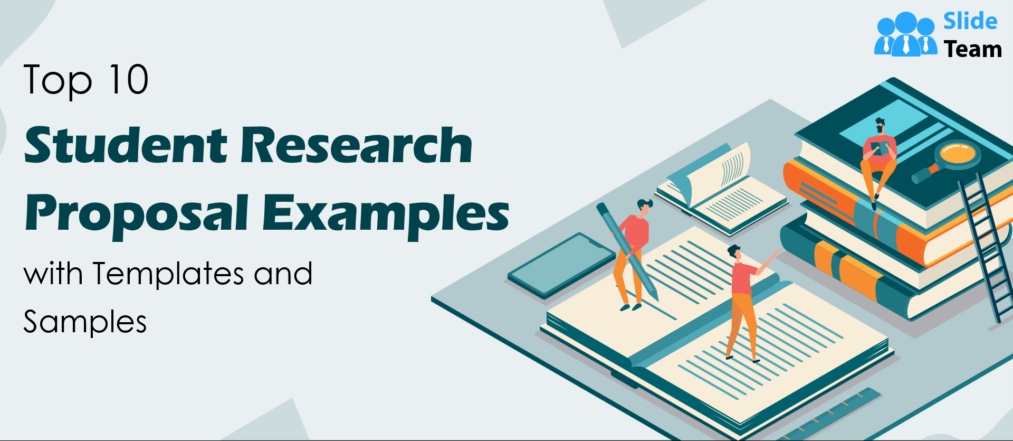
Are you struggling with crafting an appealing student research proposal ? Research shows that an estimated 6 of 10 students face difficulties in writing proposals at least initially - often leading to stress (Edu Survey Insights 2022).
Innovation and research are at the core of progress; therefore, a thoughtful research proposal cannot be understated. A research proposal's quality and impact could make or break your academic journey in a highly competitive environment.
Don't fret; SlideTeam Student Research Proposal Templates, renowned for their innovation and versatility can help you outshine all your competitors. Our templates are well-crafted not only to simplify proposal-writing processes but to also increase the chances of approval.
Check out our blog on University Proposal Templates for result-driven outcomes!
Join us on our journey to transform the way research proposal presentation templates work!
Let's dive right in!
Template 1: Cover Letter for Academic Student Research Proposal
This PPT Slide includes essential details, including its title, student identification number, crucial university, degree program information, primary supervisor contact details, and proposal submission date. It can benefit students preparing to present their research proposal to academic committees, advisors or potential collaborators. This premium PPT Slide provides a professional yet structured introduction to the proposal, with all critical details displayed prominently.
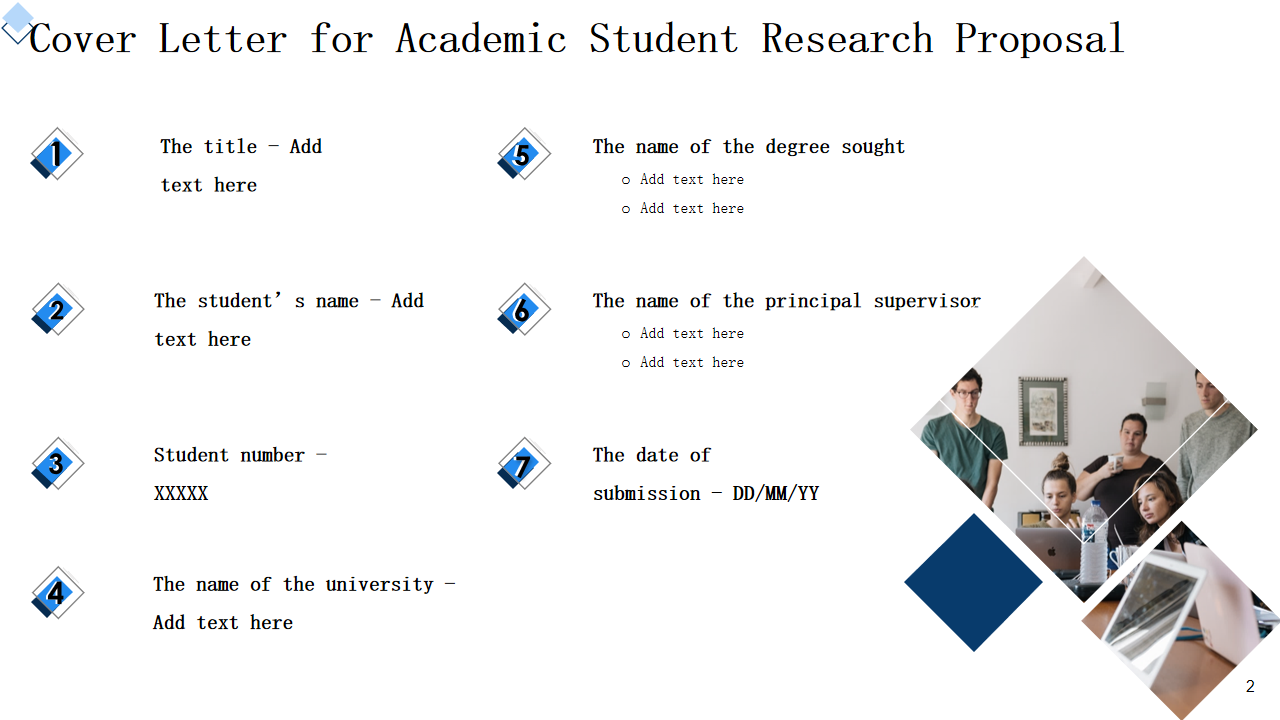
DOWNLOAD NOW
Template 2: Abstract for Academic Student Research Proposal
Here is a professional PowerPoint Template that includes critical elements such as the subject of study, objectives of the research project, potential contributions of the thesis to society/profession/technology, anticipated outcomes/expectations, and research methods employed during the project. This Slide allows students to present an accurate and brief overview of their proposed study. Students and researchers can use this PPT Slide to convey the significance and essence of their research proposals effectively.
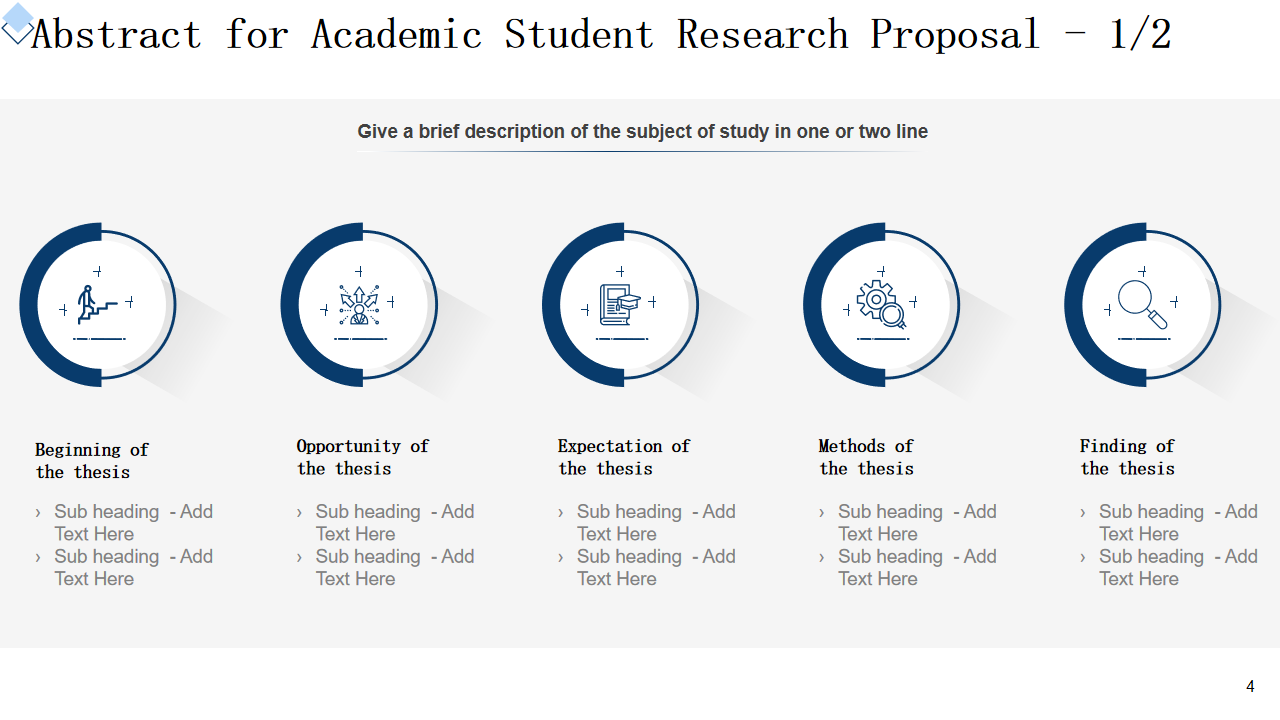
Template 3: Research Questions for Academic Student Research Proposal
This PPT Slide encompasses key components like sample size requirements, required methodological steps to reach objectives, additional research inquiries needed to fulfil goals, primary hypothesis statement, and expected impacts of proposed research. It serves as a crucial part of research proposal presentations, enabling students to outline their research project's fundamental inquiries and goals. Students and researchers can use this slide to outline their research questions, objectives, and expected outcomes.
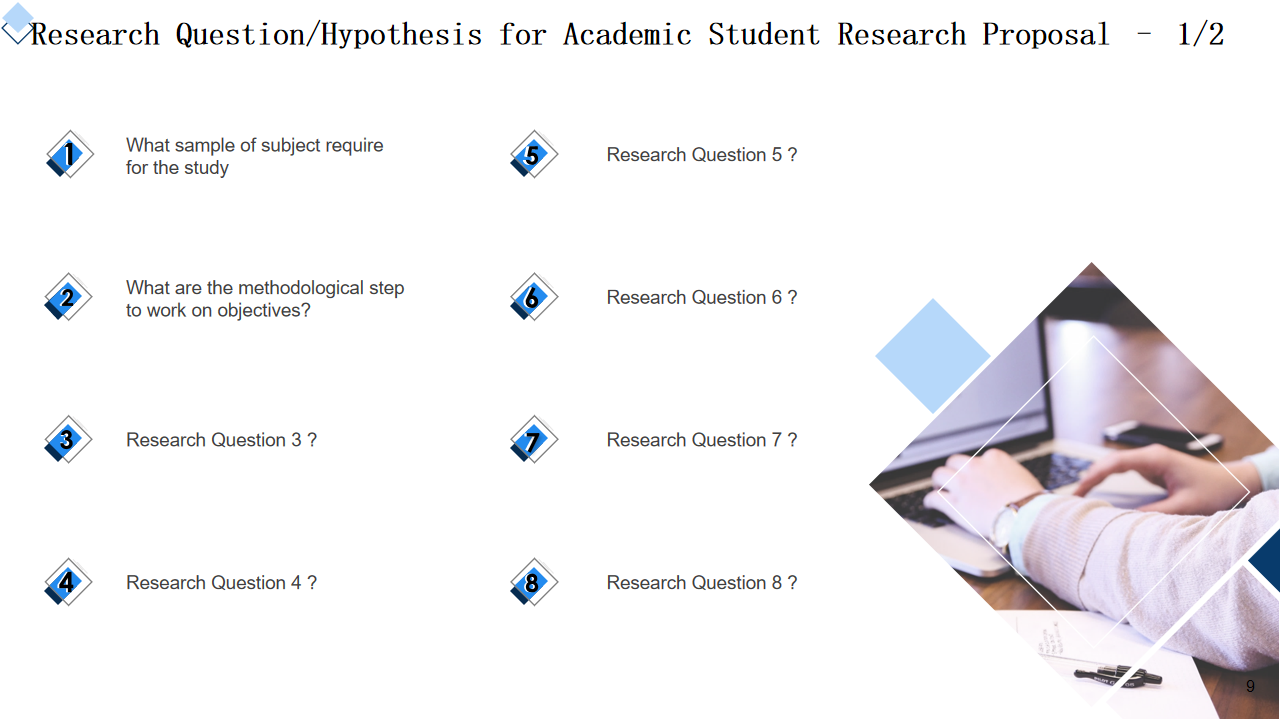
Template 4: Research Method Overview for Academic Student Research Proposal
This PPT Slide covers elements such as the logical steps that guide research area processes, strategies to address research problems, specific actions to take in response to them, methods and techniques being used, target areas of study to be studied through, execution plans as well as types of research being done. This PPT Layout is an integral component of research proposal presentations, outlining the methodology employed during research projects and explicitly designed for academic students who wish to convey the systematic approach when seeking approval or feedback from advisors or committees.
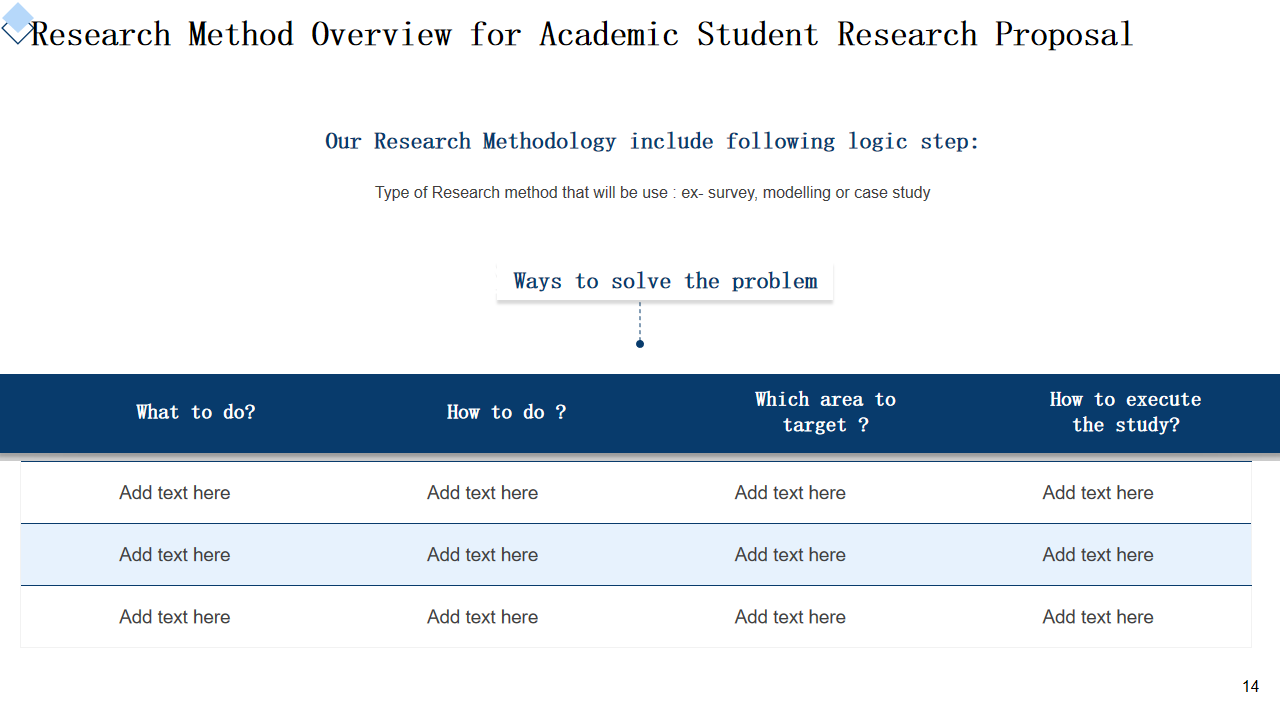
Template 5: Research Constraints for Academic Student Research Proposal
This ready to use PPT Slide includes issues like lacking prior studies in an area, restricting scope or difficulties establishing significant relationships due to small sample sizes. It is a top-notch PowerPoint Template that provides you with clarity regarding potential challenges and pitfalls related to the project. Academic students can use this slide as part of their presentation to convey challenges related to their proposed research on the target population . Download now to mitigate those constraints.
Get an insight on our Research Paper Proposal Templates blog for better growth!
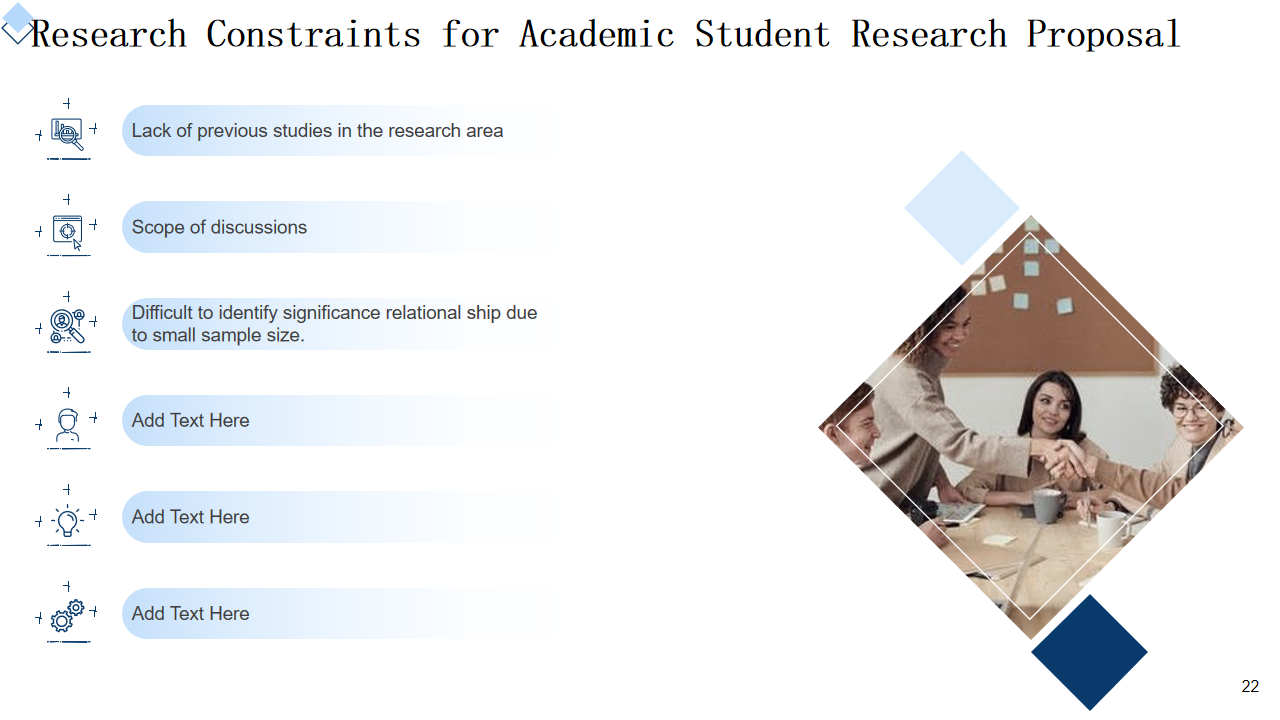
Template 6: Project Context and Objectives for Academic Student Research Proposal
This PPT Slide gives a comprehensive overview of your proposed research's context and objectives such as, goals it intends to meet. This Template serves as the core element in research proposal presentations by providing clarity about its purpose and what goals will be accomplished through your proposed work. Designed specifically for use by academic students to present rationale and objectives of their proposed studies to their peers. Academic students can deploy this PowerPoint Layout to provide their audience with a concise summary of their research proposal and its goals and context.
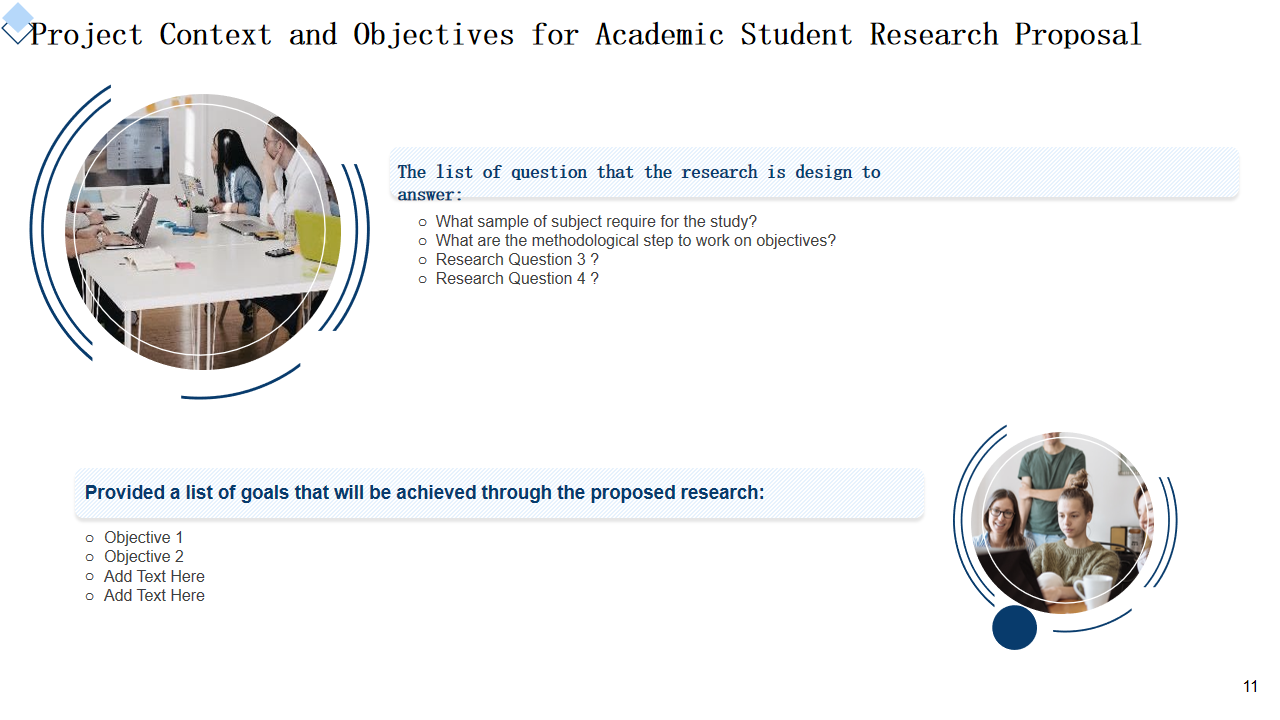
Template 7: Plan of Action for Academic Student Research Proposal
This PPT Slide outlines key components of research proposals by academic students such as, selecting their topic, outlining their knowledge, background of study, significance of study, etc. It serves as an integral element for presentation purposes by academic students presenting their proposal to demonstrate readiness and comprehension of the research process. Academic students should use this Slide to clearly communicate their research plan and preparation.
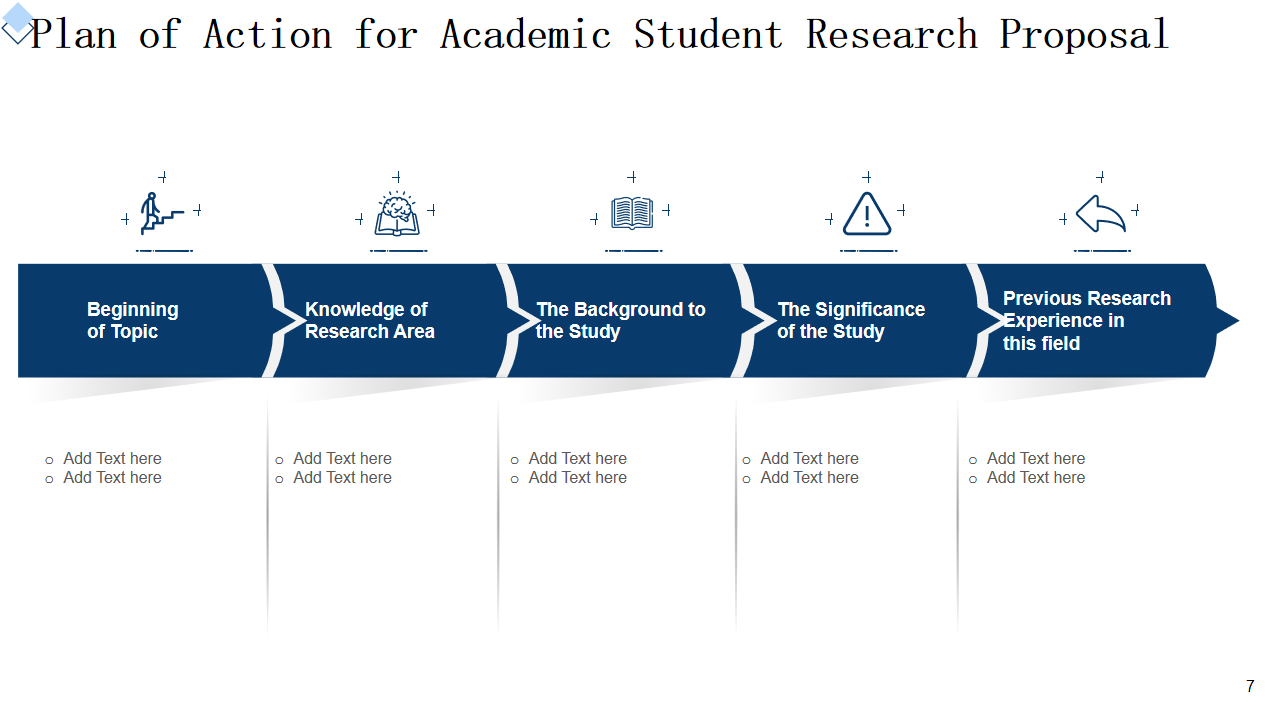
Template 8: Literature Review for Academic Student Research Proposal
This is a premium PowerPoint Template comprising key elements including a concise summation, about referenced materials, an account of previous work in the field, books or study materials consulted, and an overview of research study approach and analysis. It serves as an essential element in research proposal presentations designed for use by academic students so as to demonstrate their familiarity with existing literature as well as contextual knowledge relevant to their proposed research proposal presentation - perfect for research proposal presentations designed by academic students themselves!
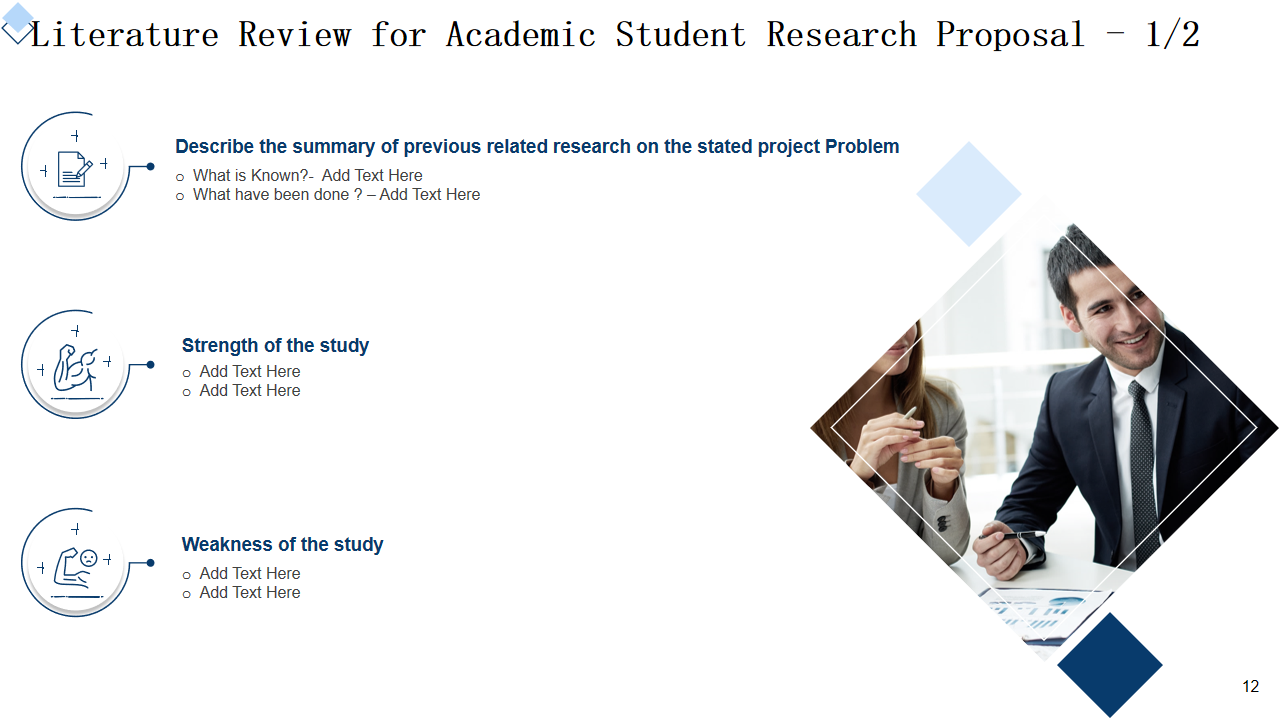
Template 9: Data Analysis Strategies for Academic Student Research Proposal
This ready to use PPT Slide outlines the planned approaches for analyzing data in the proposed research. It encompasses qualitative data analysis methods such as, content analysis, narrative analysis, regression analysis and situational analysis. This PPT Diagram is a crucial component of the research proposal presentation, designed for use by academic students to convey their well-thought-out strategies for deriving meaningful insights from their data. Academic students can incorporate this PPT Template to showcase their proficiency in data analysis strategies.
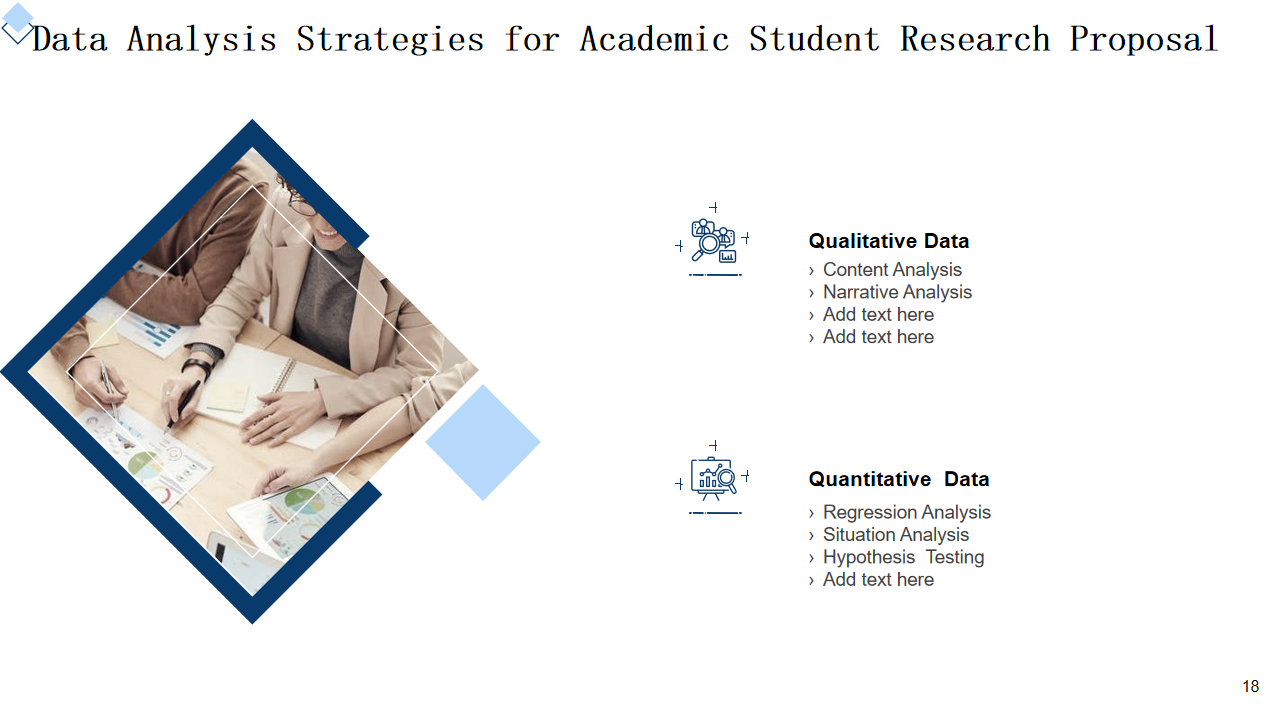
Template 10: Research Project Time-frame for Academic Student Research Proposal
This is an actionable PPT Template that provides you with an in-depth timeline for any proposed research project. It contains milestones to mark key events during its course, weekly activities that illustrate various phases, and a map outlining all phases. It serves as an essential element in research proposal presentations by providing a clear roadmap of its timeline as well as showing its feasibility; intended to aid academic students conveying structured timelines of projects to advisors, peers or evaluators. Academic students should make use of this slide to emphasize their meticulous planning and time management abilities.
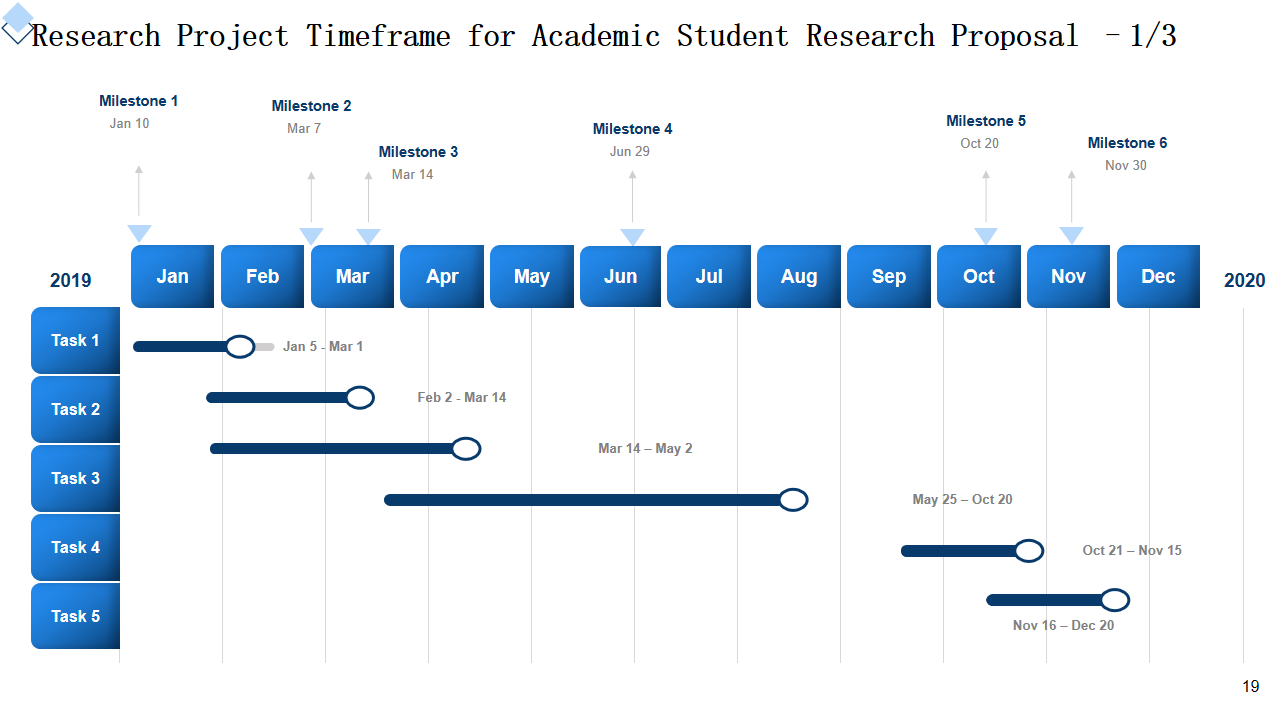
Reign Supreme with Us
Student research proposals are essential tools in academic and research pursuits. SlideTeam Templates can be invaluable, whether you are a student seeking guidance or a researcher looking to enhance their proposal by accessing their templates and samples to streamline research proposal creation and increase chances of academic success. Explore and get ahead.
Read on our blog on Proposal Cover Page Templates to make research more effective!
FAQs on Student Research Proposal
What is a student research proposal.
Student research proposals are formal documents outlining a research project or study proposed by students, which serve as blueprints for their research project or study. A good proposal includes sections such as research question/hypothesis, literature review, design methods for data collection, timeline, timeline projection and timeline plan. A well-crafted student research proposal clarifies research objectives while showing knowledge and providing guidance for conducting the study. It may serve as the basis for seeking approval, funding or academic supervision of the study.
What is a sample research proposal?
Sample research proposals serve as models or templates of research proposal documents to demonstrate how to effectively structure and present research projects. They also act as guides, providing researchers with information regarding expected formats and content requirements of proposals for research projects. Sample proposals are invaluable tools that provide a clear framework for outlining research objectives, methodologies, literature reviews and timelines. Researchers can use these sample proposals as guides when crafting their proposals to ensure they adhere to established standards and best practices. Although sample research proposals must always be customized specifically for a research project's requirements, these sample research proposals serve as applicable starting points.
What are the 7 parts of the research proposal?
An effective research proposal typically comprises seven components.
- Title: When writing the title for any research topic, its focus must be clearly communicated and capture the reader's interest quickly and succinctly.
- Introduction: This section introduces the research problem, its context, and the significance of the study. It sets the stage for your proposal.
- Literature Review: Existing research on the topic under consideration is reviewed and analyzed to demonstrate any gaps or knowledge deficits needed by this proposed research project.
- Research Objectives or Questions: Your objectives or questions for the study must be clear. Outline what you want to accomplish or investigate through your investigation.
- Methodology: Provide an in-depth and organized account of the research methods, data collection techniques, and analytic procedures you plan to employ in this section.
- Significance and Contributions: Detail your research's potential repercussions and contributions regarding relevance and importance to its field.
- Referencing: Please alphabetically list all sources and references used within your proposal using an established style (APA or MLA).
Why choose student research proposal templates?
Student Research Proposal Templates provide numerous advantages for academic and research pursuits. First, they provide a structured framework that makes creating proposals faster and more straightforward - saving time and energy. Industry experts and academic requirements have developed these templates to make your proposal comply with standards and academic regulations. Furthermore, these educational resources serve as guides on best practices for writing research proposals. Customizable and versatile templates adapt well to various research domains, making them suitable for various projects. Opting for such templates provides students a valuable resource that enhances proposal quality, fosters learning experiences, and streamlines research endeavors.
Related posts:
- Top 10 Quantitative Research Proposal Examples with Templates and Samples
- Must-have Research Proposal for Ph.D. Interview PPT Templates with Samples and Examples
- Top 10 Action Plan Proposal Templates with Examples and Samples
- Research Project Proposal Templates That Ace Your Funding Quest!
Liked this blog? Please recommend us

Must-Have Team Contract Templates with Samples and Examples
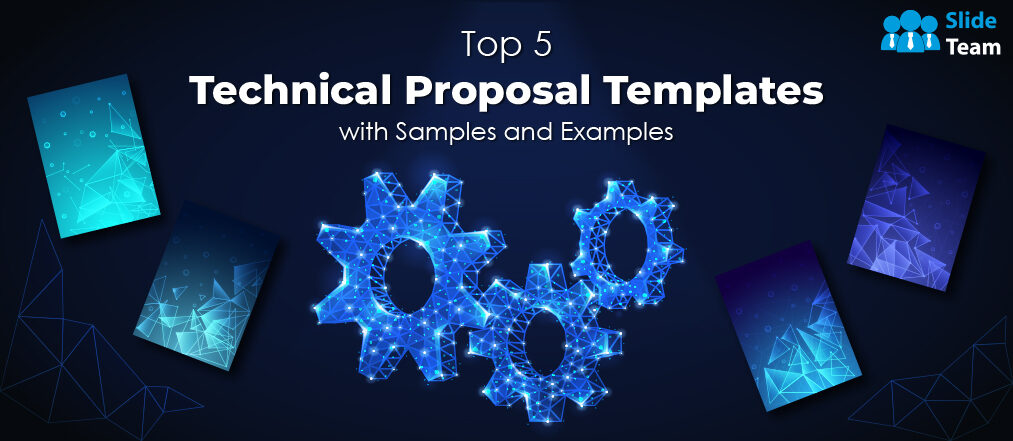
Top 5 Technical Proposal Templates with Samples and Examples
This form is protected by reCAPTCHA - the Google Privacy Policy and Terms of Service apply.

Digital revolution powerpoint presentation slides

Sales funnel results presentation layouts

3d men joinning circular jigsaw puzzles ppt graphics icons

Business Strategic Planning Template For Organizations Powerpoint Presentation Slides

Future plan powerpoint template slide

Project Management Team Powerpoint Presentation Slides

Brand marketing powerpoint presentation slides

Launching a new service powerpoint presentation with slides go to market

Agenda powerpoint slide show

Four key metrics donut chart with percentage

Engineering and technology ppt inspiration example introduction continuous process improvement

Meet our team representing in circular format

17 Research Proposal Examples

A research proposal systematically and transparently outlines a proposed research project.
The purpose of a research proposal is to demonstrate a project’s viability and the researcher’s preparedness to conduct an academic study. It serves as a roadmap for the researcher.
The process holds value both externally (for accountability purposes and often as a requirement for a grant application) and intrinsic value (for helping the researcher to clarify the mechanics, purpose, and potential signficance of the study).
Key sections of a research proposal include: the title, abstract, introduction, literature review, research design and methods, timeline, budget, outcomes and implications, references, and appendix. Each is briefly explained below.
Watch my Guide: How to Write a Research Proposal
Get your Template for Writing your Research Proposal Here (With AI Prompts!)
Research Proposal Sample Structure
Title: The title should present a concise and descriptive statement that clearly conveys the core idea of the research projects. Make it as specific as possible. The reader should immediately be able to grasp the core idea of the intended research project. Often, the title is left too vague and does not help give an understanding of what exactly the study looks at.
Abstract: Abstracts are usually around 250-300 words and provide an overview of what is to follow – including the research problem , objectives, methods, expected outcomes, and significance of the study. Use it as a roadmap and ensure that, if the abstract is the only thing someone reads, they’ll get a good fly-by of what will be discussed in the peice.
Introduction: Introductions are all about contextualization. They often set the background information with a statement of the problem. At the end of the introduction, the reader should understand what the rationale for the study truly is. I like to see the research questions or hypotheses included in the introduction and I like to get a good understanding of what the significance of the research will be. It’s often easiest to write the introduction last
Literature Review: The literature review dives deep into the existing literature on the topic, demosntrating your thorough understanding of the existing literature including themes, strengths, weaknesses, and gaps in the literature. It serves both to demonstrate your knowledge of the field and, to demonstrate how the proposed study will fit alongside the literature on the topic. A good literature review concludes by clearly demonstrating how your research will contribute something new and innovative to the conversation in the literature.
Research Design and Methods: This section needs to clearly demonstrate how the data will be gathered and analyzed in a systematic and academically sound manner. Here, you need to demonstrate that the conclusions of your research will be both valid and reliable. Common points discussed in the research design and methods section include highlighting the research paradigm, methodologies, intended population or sample to be studied, data collection techniques, and data analysis procedures . Toward the end of this section, you are encouraged to also address ethical considerations and limitations of the research process , but also to explain why you chose your research design and how you are mitigating the identified risks and limitations.
Timeline: Provide an outline of the anticipated timeline for the study. Break it down into its various stages (including data collection, data analysis, and report writing). The goal of this section is firstly to establish a reasonable breakdown of steps for you to follow and secondly to demonstrate to the assessors that your project is practicable and feasible.
Budget: Estimate the costs associated with the research project and include evidence for your estimations. Typical costs include staffing costs, equipment, travel, and data collection tools. When applying for a scholarship, the budget should demonstrate that you are being responsible with your expensive and that your funding application is reasonable.
Expected Outcomes and Implications: A discussion of the anticipated findings or results of the research, as well as the potential contributions to the existing knowledge, theory, or practice in the field. This section should also address the potential impact of the research on relevant stakeholders and any broader implications for policy or practice.
References: A complete list of all the sources cited in the research proposal, formatted according to the required citation style. This demonstrates the researcher’s familiarity with the relevant literature and ensures proper attribution of ideas and information.
Appendices (if applicable): Any additional materials, such as questionnaires, interview guides, or consent forms, that provide further information or support for the research proposal. These materials should be included as appendices at the end of the document.
Research Proposal Examples
Research proposals often extend anywhere between 2,000 and 15,000 words in length. The following snippets are samples designed to briefly demonstrate what might be discussed in each section.
1. Education Studies Research Proposals
See some real sample pieces:
- Assessment of the perceptions of teachers towards a new grading system
- Does ICT use in secondary classrooms help or hinder student learning?
- Digital technologies in focus project
- Urban Middle School Teachers’ Experiences of the Implementation of
- Restorative Justice Practices
- Experiences of students of color in service learning
Consider this hypothetical education research proposal:
The Impact of Game-Based Learning on Student Engagement and Academic Performance in Middle School Mathematics
Abstract: The proposed study will explore multiplayer game-based learning techniques in middle school mathematics curricula and their effects on student engagement. The study aims to contribute to the current literature on game-based learning by examining the effects of multiplayer gaming in learning.
Introduction: Digital game-based learning has long been shunned within mathematics education for fears that it may distract students or lower the academic integrity of the classrooms. However, there is emerging evidence that digital games in math have emerging benefits not only for engagement but also academic skill development. Contributing to this discourse, this study seeks to explore the potential benefits of multiplayer digital game-based learning by examining its impact on middle school students’ engagement and academic performance in a mathematics class.
Literature Review: The literature review has identified gaps in the current knowledge, namely, while game-based learning has been extensively explored, the role of multiplayer games in supporting learning has not been studied.
Research Design and Methods: This study will employ a mixed-methods research design based upon action research in the classroom. A quasi-experimental pre-test/post-test control group design will first be used to compare the academic performance and engagement of middle school students exposed to game-based learning techniques with those in a control group receiving instruction without the aid of technology. Students will also be observed and interviewed in regard to the effect of communication and collaboration during gameplay on their learning.
Timeline: The study will take place across the second term of the school year with a pre-test taking place on the first day of the term and the post-test taking place on Wednesday in Week 10.
Budget: The key budgetary requirements will be the technologies required, including the subscription cost for the identified games and computers.
Expected Outcomes and Implications: It is expected that the findings will contribute to the current literature on game-based learning and inform educational practices, providing educators and policymakers with insights into how to better support student achievement in mathematics.
2. Psychology Research Proposals
See some real examples:
- A situational analysis of shared leadership in a self-managing team
- The effect of musical preference on running performance
- Relationship between self-esteem and disordered eating amongst adolescent females
Consider this hypothetical psychology research proposal:
The Effects of Mindfulness-Based Interventions on Stress Reduction in College Students
Abstract: This research proposal examines the impact of mindfulness-based interventions on stress reduction among college students, using a pre-test/post-test experimental design with both quantitative and qualitative data collection methods .
Introduction: College students face heightened stress levels during exam weeks. This can affect both mental health and test performance. This study explores the potential benefits of mindfulness-based interventions such as meditation as a way to mediate stress levels in the weeks leading up to exam time.
Literature Review: Existing research on mindfulness-based meditation has shown the ability for mindfulness to increase metacognition, decrease anxiety levels, and decrease stress. Existing literature has looked at workplace, high school and general college-level applications. This study will contribute to the corpus of literature by exploring the effects of mindfulness directly in the context of exam weeks.
Research Design and Methods: Participants ( n= 234 ) will be randomly assigned to either an experimental group, receiving 5 days per week of 10-minute mindfulness-based interventions, or a control group, receiving no intervention. Data will be collected through self-report questionnaires, measuring stress levels, semi-structured interviews exploring participants’ experiences, and students’ test scores.
Timeline: The study will begin three weeks before the students’ exam week and conclude after each student’s final exam. Data collection will occur at the beginning (pre-test of self-reported stress levels) and end (post-test) of the three weeks.
Expected Outcomes and Implications: The study aims to provide evidence supporting the effectiveness of mindfulness-based interventions in reducing stress among college students in the lead up to exams, with potential implications for mental health support and stress management programs on college campuses.
3. Sociology Research Proposals
- Understanding emerging social movements: A case study of ‘Jersey in Transition’
- The interaction of health, education and employment in Western China
- Can we preserve lower-income affordable neighbourhoods in the face of rising costs?
Consider this hypothetical sociology research proposal:
The Impact of Social Media Usage on Interpersonal Relationships among Young Adults
Abstract: This research proposal investigates the effects of social media usage on interpersonal relationships among young adults, using a longitudinal mixed-methods approach with ongoing semi-structured interviews to collect qualitative data.
Introduction: Social media platforms have become a key medium for the development of interpersonal relationships, particularly for young adults. This study examines the potential positive and negative effects of social media usage on young adults’ relationships and development over time.
Literature Review: A preliminary review of relevant literature has demonstrated that social media usage is central to development of a personal identity and relationships with others with similar subcultural interests. However, it has also been accompanied by data on mental health deline and deteriorating off-screen relationships. The literature is to-date lacking important longitudinal data on these topics.
Research Design and Methods: Participants ( n = 454 ) will be young adults aged 18-24. Ongoing self-report surveys will assess participants’ social media usage, relationship satisfaction, and communication patterns. A subset of participants will be selected for longitudinal in-depth interviews starting at age 18 and continuing for 5 years.
Timeline: The study will be conducted over a period of five years, including recruitment, data collection, analysis, and report writing.
Expected Outcomes and Implications: This study aims to provide insights into the complex relationship between social media usage and interpersonal relationships among young adults, potentially informing social policies and mental health support related to social media use.
4. Nursing Research Proposals
- Does Orthopaedic Pre-assessment clinic prepare the patient for admission to hospital?
- Nurses’ perceptions and experiences of providing psychological care to burns patients
- Registered psychiatric nurse’s practice with mentally ill parents and their children
Consider this hypothetical nursing research proposal:
The Influence of Nurse-Patient Communication on Patient Satisfaction and Health Outcomes following Emergency Cesarians
Abstract: This research will examines the impact of effective nurse-patient communication on patient satisfaction and health outcomes for women following c-sections, utilizing a mixed-methods approach with patient surveys and semi-structured interviews.
Introduction: It has long been known that effective communication between nurses and patients is crucial for quality care. However, additional complications arise following emergency c-sections due to the interaction between new mother’s changing roles and recovery from surgery.
Literature Review: A review of the literature demonstrates the importance of nurse-patient communication, its impact on patient satisfaction, and potential links to health outcomes. However, communication between nurses and new mothers is less examined, and the specific experiences of those who have given birth via emergency c-section are to date unexamined.
Research Design and Methods: Participants will be patients in a hospital setting who have recently had an emergency c-section. A self-report survey will assess their satisfaction with nurse-patient communication and perceived health outcomes. A subset of participants will be selected for in-depth interviews to explore their experiences and perceptions of the communication with their nurses.
Timeline: The study will be conducted over a period of six months, including rolling recruitment, data collection, analysis, and report writing within the hospital.
Expected Outcomes and Implications: This study aims to provide evidence for the significance of nurse-patient communication in supporting new mothers who have had an emergency c-section. Recommendations will be presented for supporting nurses and midwives in improving outcomes for new mothers who had complications during birth.
5. Social Work Research Proposals
- Experiences of negotiating employment and caring responsibilities of fathers post-divorce
- Exploring kinship care in the north region of British Columbia
Consider this hypothetical social work research proposal:
The Role of a Family-Centered Intervention in Preventing Homelessness Among At-Risk Youthin a working-class town in Northern England
Abstract: This research proposal investigates the effectiveness of a family-centered intervention provided by a local council area in preventing homelessness among at-risk youth. This case study will use a mixed-methods approach with program evaluation data and semi-structured interviews to collect quantitative and qualitative data .
Introduction: Homelessness among youth remains a significant social issue. This study aims to assess the effectiveness of family-centered interventions in addressing this problem and identify factors that contribute to successful prevention strategies.
Literature Review: A review of the literature has demonstrated several key factors contributing to youth homelessness including lack of parental support, lack of social support, and low levels of family involvement. It also demonstrates the important role of family-centered interventions in addressing this issue. Drawing on current evidence, this study explores the effectiveness of one such intervention in preventing homelessness among at-risk youth in a working-class town in Northern England.
Research Design and Methods: The study will evaluate a new family-centered intervention program targeting at-risk youth and their families. Quantitative data on program outcomes, including housing stability and family functioning, will be collected through program records and evaluation reports. Semi-structured interviews with program staff, participants, and relevant stakeholders will provide qualitative insights into the factors contributing to program success or failure.
Timeline: The study will be conducted over a period of six months, including recruitment, data collection, analysis, and report writing.
Budget: Expenses include access to program evaluation data, interview materials, data analysis software, and any related travel costs for in-person interviews.
Expected Outcomes and Implications: This study aims to provide evidence for the effectiveness of family-centered interventions in preventing youth homelessness, potentially informing the expansion of or necessary changes to social work practices in Northern England.
Research Proposal Template
Get your Detailed Template for Writing your Research Proposal Here (With AI Prompts!)
This is a template for a 2500-word research proposal. You may find it difficult to squeeze everything into this wordcount, but it’s a common wordcount for Honors and MA-level dissertations.
Your research proposal is where you really get going with your study. I’d strongly recommend working closely with your teacher in developing a research proposal that’s consistent with the requirements and culture of your institution, as in my experience it varies considerably. The above template is from my own courses that walk students through research proposals in a British School of Education.

Chris Drew (PhD)
Dr. Chris Drew is the founder of the Helpful Professor. He holds a PhD in education and has published over 20 articles in scholarly journals. He is the former editor of the Journal of Learning Development in Higher Education. [Image Descriptor: Photo of Chris]
- Chris Drew (PhD) https://helpfulprofessor.com/author/chris-drew-phd/ 5 Top Tips for Succeeding at University
- Chris Drew (PhD) https://helpfulprofessor.com/author/chris-drew-phd/ 50 Durable Goods Examples
- Chris Drew (PhD) https://helpfulprofessor.com/author/chris-drew-phd/ 100 Consumer Goods Examples
- Chris Drew (PhD) https://helpfulprofessor.com/author/chris-drew-phd/ 30 Globalization Pros and Cons
8 thoughts on “17 Research Proposal Examples”
Very excellent research proposals
very helpful
Very helpful
Dear Sir, I need some help to write an educational research proposal. Thank you.

Hi Levi, use the site search bar to ask a question and I’ll likely have a guide already written for your specific question. Thanks for reading!
very good research proposal
Thank you so much sir! ❤️
Very helpful 👌
Leave a Comment Cancel Reply
Your email address will not be published. Required fields are marked *
Have a language expert improve your writing
Run a free plagiarism check in 10 minutes, automatically generate references for free.
- Knowledge Base
- Research process
- How to Write a Research Proposal | Examples & Templates
How to Write a Research Proposal | Examples & Templates
Published on 30 October 2022 by Shona McCombes and Tegan George. Revised on 13 June 2023.

A research proposal describes what you will investigate, why it’s important, and how you will conduct your research.
The format of a research proposal varies between fields, but most proposals will contain at least these elements:
Introduction
Literature review.
- Research design
Reference list
While the sections may vary, the overall objective is always the same. A research proposal serves as a blueprint and guide for your research plan, helping you get organised and feel confident in the path forward you choose to take.
Table of contents
Research proposal purpose, research proposal examples, research design and methods, contribution to knowledge, research schedule, frequently asked questions.
Academics often have to write research proposals to get funding for their projects. As a student, you might have to write a research proposal as part of a grad school application , or prior to starting your thesis or dissertation .
In addition to helping you figure out what your research can look like, a proposal can also serve to demonstrate why your project is worth pursuing to a funder, educational institution, or supervisor.
Research proposal length
The length of a research proposal can vary quite a bit. A bachelor’s or master’s thesis proposal can be just a few pages, while proposals for PhD dissertations or research funding are usually much longer and more detailed. Your supervisor can help you determine the best length for your work.
One trick to get started is to think of your proposal’s structure as a shorter version of your thesis or dissertation , only without the results , conclusion and discussion sections.
Download our research proposal template
Prevent plagiarism, run a free check.
Writing a research proposal can be quite challenging, but a good starting point could be to look at some examples. We’ve included a few for you below.
- Example research proposal #1: ‘A Conceptual Framework for Scheduling Constraint Management’
- Example research proposal #2: ‘ Medical Students as Mediators of Change in Tobacco Use’
Like your dissertation or thesis, the proposal will usually have a title page that includes:
- The proposed title of your project
- Your supervisor’s name
- Your institution and department
The first part of your proposal is the initial pitch for your project. Make sure it succinctly explains what you want to do and why.
Your introduction should:
- Introduce your topic
- Give necessary background and context
- Outline your problem statement and research questions
To guide your introduction , include information about:
- Who could have an interest in the topic (e.g., scientists, policymakers)
- How much is already known about the topic
- What is missing from this current knowledge
- What new insights your research will contribute
- Why you believe this research is worth doing
As you get started, it’s important to demonstrate that you’re familiar with the most important research on your topic. A strong literature review shows your reader that your project has a solid foundation in existing knowledge or theory. It also shows that you’re not simply repeating what other people have already done or said, but rather using existing research as a jumping-off point for your own.
In this section, share exactly how your project will contribute to ongoing conversations in the field by:
- Comparing and contrasting the main theories, methods, and debates
- Examining the strengths and weaknesses of different approaches
- Explaining how will you build on, challenge, or synthesise prior scholarship
Following the literature review, restate your main objectives . This brings the focus back to your own project. Next, your research design or methodology section will describe your overall approach, and the practical steps you will take to answer your research questions.
To finish your proposal on a strong note, explore the potential implications of your research for your field. Emphasise again what you aim to contribute and why it matters.
For example, your results might have implications for:
- Improving best practices
- Informing policymaking decisions
- Strengthening a theory or model
- Challenging popular or scientific beliefs
- Creating a basis for future research
Last but not least, your research proposal must include correct citations for every source you have used, compiled in a reference list . To create citations quickly and easily, you can use our free APA citation generator .
Some institutions or funders require a detailed timeline of the project, asking you to forecast what you will do at each stage and how long it may take. While not always required, be sure to check the requirements of your project.
Here’s an example schedule to help you get started. You can also download a template at the button below.
Download our research schedule template
If you are applying for research funding, chances are you will have to include a detailed budget. This shows your estimates of how much each part of your project will cost.
Make sure to check what type of costs the funding body will agree to cover. For each item, include:
- Cost : exactly how much money do you need?
- Justification : why is this cost necessary to complete the research?
- Source : how did you calculate the amount?
To determine your budget, think about:
- Travel costs : do you need to go somewhere to collect your data? How will you get there, and how much time will you need? What will you do there (e.g., interviews, archival research)?
- Materials : do you need access to any tools or technologies?
- Help : do you need to hire any research assistants for the project? What will they do, and how much will you pay them?
Once you’ve decided on your research objectives , you need to explain them in your paper, at the end of your problem statement.
Keep your research objectives clear and concise, and use appropriate verbs to accurately convey the work that you will carry out for each one.
I will compare …
A research aim is a broad statement indicating the general purpose of your research project. It should appear in your introduction at the end of your problem statement , before your research objectives.
Research objectives are more specific than your research aim. They indicate the specific ways you’ll address the overarching aim.
A PhD, which is short for philosophiae doctor (doctor of philosophy in Latin), is the highest university degree that can be obtained. In a PhD, students spend 3–5 years writing a dissertation , which aims to make a significant, original contribution to current knowledge.
A PhD is intended to prepare students for a career as a researcher, whether that be in academia, the public sector, or the private sector.
A master’s is a 1- or 2-year graduate degree that can prepare you for a variety of careers.
All master’s involve graduate-level coursework. Some are research-intensive and intend to prepare students for further study in a PhD; these usually require their students to write a master’s thesis . Others focus on professional training for a specific career.
Critical thinking refers to the ability to evaluate information and to be aware of biases or assumptions, including your own.
Like information literacy , it involves evaluating arguments, identifying and solving problems in an objective and systematic way, and clearly communicating your ideas.
Cite this Scribbr article
If you want to cite this source, you can copy and paste the citation or click the ‘Cite this Scribbr article’ button to automatically add the citation to our free Reference Generator.
McCombes, S. & George, T. (2023, June 13). How to Write a Research Proposal | Examples & Templates. Scribbr. Retrieved 22 April 2024, from https://www.scribbr.co.uk/the-research-process/research-proposal-explained/
Is this article helpful?
Shona McCombes
Other students also liked, what is a research methodology | steps & tips, what is a literature review | guide, template, & examples, how to write a results section | tips & examples.
How to Write a Research Paper as a High School Student

By Carly Taylor
Senior at Stanford University
6 minute read
Read our guide to learn why you should write a research paper and how to do so, from choosing the right topic to outlining and structuring your argument.
What is a research paper?
A research paper poses an answer to a specific question and defends that answer using academic sources, data, and critical reasoning. Writing a research paper is an excellent way to hone your focus during a research project , synthesize what you’re learning, and explain why your work matters to a broader audience of scholars in your field.
The types of sources and evidence you’ll see used in a research paper can vary widely based on its field of study. A history research paper might examine primary sources like journals and newspaper articles to draw conclusions about the culture of a specific time and place, whereas a biology research paper might analyze data from different published experiments and use textbook explanations of cellular pathways to identify a potential marker for breast cancer.
However, researchers across disciplines must identify and analyze credible sources, formulate a specific research question, generate a clear thesis statement, and organize their ideas in a cohesive manner to support their argument. Read on to learn how this process works and how to get started writing your own research paper.
Choosing your topic
Tap into your passions.
A research paper is your chance to explore what genuinely interests you and combine ideas in novel ways. So don’t choose a subject that simply sounds impressive or blindly follow what someone else wants you to do – choose something you’re really passionate about! You should be able to enjoy reading for hours and hours about your topic and feel enthusiastic about synthesizing and sharing what you learn.
We've created these helpful resources to inspire you to think about your own passion project . Polygence also offers a passion exploration experience where you can dive deep into three potential areas of study with expert mentors from those fields.
Ask a difficult question
In the traditional classroom, top students are expected to always know the answers to the questions the teacher asks. But a research paper is YOUR chance to pose a big question that no one has answered yet, and figure out how to make a contribution to answering that question. So don’t be afraid if you have no idea how to answer your question at the start of the research process — this will help you maintain a motivational sense of discovery as you dive deeper into your research. If you need inspiration, explore our database of research project ideas .
Be as specific as possible
It’s essential to be reasonable about what you can accomplish in one paper and narrow your focus down to an issue you can thoroughly address. For example, if you’re interested in the effects of invasive species on ecosystems, it’s best to focus on one invasive species and one ecosystem, such as iguanas in South Florida , or one survival mechanism, such as supercolonies in invasive ant species . If you can, get hands on with your project.
You should approach your paper with the mindset of becoming an expert in this topic. Narrowing your focus will help you achieve this goal without getting lost in the weeds and overwhelming yourself.
Would you like to write your own research paper?
Polygence mentors can help you every step of the way in writing and showcasing your research paper
Preparing to write
Conduct preliminary research.
Before you dive into writing your research paper, conduct a literature review to see what’s already known about your topic. This can help you find your niche within the existing body of research and formulate your question. For example, Polygence student Jasmita found that researchers had studied the effects of background music on student test performance, but they had not taken into account the effect of a student’s familiarity with the music being played, so she decided to pose this new question in her research paper.
Pro tip: It’s a good idea to skim articles in order to decide whether they’re relevant enough to your research interest before committing to reading them in full. This can help you spend as much time as possible with the sources you’ll actually cite in your paper.
Skimming articles will help you gain a broad-strokes view of the different pockets of existing knowledge in your field and identify the most potentially useful sources. Reading articles in full will allow you to accumulate specific evidence related to your research question and begin to formulate an answer to it.
Draft a thesis statement
Your thesis statement is your succinctly-stated answer to the question you’re posing, which you’ll make your case for in the body of the paper. For example, if you’re studying the effect of K-pop on eating disorders and body image in teenagers of different races, your thesis may be that Asian teenagers who are exposed to K-pop videos experience more negative effects on their body image than Caucasian teenagers.
Pro Tip: It’s okay to refine your thesis as you continue to learn more throughout your research and writing process! A preliminary thesis will help you come up with a structure for presenting your argument, but you should absolutely change your thesis if new information you uncover changes your perspective or adds nuance to it.
Create an outline
An outline is a tool for sketching out the structure of your paper by organizing your points broadly into subheadings and more finely into individual paragraphs. Try putting your thesis at the top of your outline, then brainstorm all the points you need to convey in order to support your thesis.
Pro Tip : Your outline is just a jumping-off point – it will evolve as you gain greater clarity on your argument through your writing and continued research. Sometimes, it takes several iterations of outlining, then writing, then re-outlining, then rewriting in order to find the best structure for your paper.
Writing your paper
Introduction.
Your introduction should move the reader from your broad area of interest into your specific area of focus for the paper. It generally takes the form of one to two paragraphs that build to your thesis statement and give the reader an idea of the broad argumentative structure of your paper. After reading your introduction, your reader should know what claim you’re going to present and what kinds of evidence you’ll analyze to support it.
Topic sentences
Writing crystal clear topic sentences is a crucial aspect of a successful research paper. A topic sentence is like the thesis statement of a particular paragraph – it should clearly state the point that the paragraph will make. Writing focused topic sentences will help you remain focused while writing your paragraphs and will ensure that the reader can clearly grasp the function of each paragraph in the paper’s overall structure.
Transitions
Sophisticated research papers move beyond tacking on simple transitional phrases such as “Secondly” or “Moreover” to the start of each new paragraph. Instead, each paragraph flows naturally into the next one, with the connection between each idea made very clear. Try using specifically-crafted transitional phrases rather than stock phrases to move from one point to the next that will make your paper as cohesive as possible.
In her research paper on Pakistani youth in the U.S. , Polygence student Iba used the following specifically-crafted transition to move between two paragraphs: “Although the struggles of digital ethnography limited some data collection, there are also many advantages of digital data collection.” This sentence provides the logical link between the discussion of the limitations of digital ethnography from the prior paragraph and the upcoming discussion of this techniques’ advantages in this paragraph.
Your conclusion can have several functions:
To drive home your thesis and summarize your argument
To emphasize the broader significance of your findings and answer the “so what” question
To point out some questions raised by your thesis and/or opportunities for further research
Your conclusion can take on all three of these tasks or just one, depending on what you feel your paper is still lacking up to this point.
Citing sources
Last but not least, giving credit to your sources is extremely important. There are many different citation formats such as MLA, APA, and Chicago style. Make sure you know which one is standard in your field of interest by researching online or consulting an expert.
You have several options for keeping track of your bibliography:
Use a notebook to record the relevant information from each of your sources: title, author, date of publication, journal name, page numbers, etc.
Create a folder on your computer where you can store your electronic sources
Use an online bibliography creator such as Zotero, Easybib, or Noodletools to track sources and generate citations
You can read research papers by Polygence students under our Projects tab. You can also explore other opportunities for high school research .
If you’re interested in finding an expert mentor to guide you through the process of writing your own independent research paper, consider applying to be a Polygence scholar today!
Your research paper help even you to earn college credit , get published in an academic journal , contribute to your application for college , improve your college admissions chances !
Feeling Inspired?
Interested in doing an exciting research project? Click below to get matched with one of our expert mentors!
We use cookies to enhance our website for you. Proceed if you agree to this policy or learn more about it.
- Essay Database >
- Essays Samples >
- Essay Types >
- Research Proposal Example
High School Research Proposals Samples For Students
32 samples of this type
If you're looking for a possible method to simplify writing a Research Proposal about High School, WowEssays.com paper writing service just might be able to help you out.
For starters, you should skim our extensive directory of free samples that cover most diverse High School Research Proposal topics and showcase the best academic writing practices. Once you feel that you've analyzed the key principles of content structuring and drawn actionable insights from these expertly written Research Proposal samples, developing your own academic work should go much easier.
However, you might still find yourself in a circumstance when even using top-notch High School Research Proposals doesn't let you get the job done on time. In that case, you can get in touch with our experts and ask them to craft a unique High School paper according to your individual specifications. Buy college research paper or essay now!
International Trade and Human Rights Research Proposal
Good research proposal about parental involvement in secondary education and its effect on student motivation, free arts & sciences program research proposal sample, communication 151.
Bullying among male and female high school students in the UAE Proposal ____________________________________________________________________________________________
Section: 51
Don't waste your time searching for a sample.
Get your research proposal done by professional writers!
Just from $10/page
Good Research Proposal About Gcu: Res 880
Dropping Out or Pushed Out: The Impact of High School Dropout Rate Relative to High Stakes Testing Policy in Wayne County, State of Michigan
Dissertation Prospectus Dropping Out or Pushed Out: The Impact of High School Dropout Rate Relative to High Stakes Testing Policy in Wayne County, State of Michigan <Insert Chair Name>
Dissertation Prospectus
Problem statement research proposal example.
Dropping Out or Pushed Out: The Impact of High School Dropout Rate Relative To High Stakes Testing Policy In The State Of Michigan
Introduction
Recruitment of army officers in high school research proposal examples, should the government abandon recruitment of army officers in high school research proposal examples.
Research Topic and Research Question The research labors to find out the effects of recruiting army officers in high school. Upon finding out the effects of recruiting the officers at the tender age, it then sets to answer the question,
Should the government abandon recruitment of army officers in high school?
Preparing design and technology students for the future research proposal, research proposal about cyberbullying among 13-19 y.o. schoolchildren, good example of youth senior activity summer program in rural groton, vermont research proposal, good research proposal about what is the best way to prevent teen pregnancy, classical english literature, good example of nature of the problem research proposal, introduction to the topic, research proposal on whiteboard on mathematics classroom, virtual architecture model, research background and review of related literatures research proposal example.
The objective of the present study is to determine the effects of implementing a policy that requires the students of a subject educational institution to wear a school uniform when going to school. The working hypothesis in this paper suggests that wearing school uniforms directly and positively affects the student’s educational outcomes (and academic achievement levels). For the second part of the proposal, the author focuses on reviewing the current best evidence on the topic of wearing school uniforms.
Free Conduct A Literature Review Research Proposal Sample
Free problem statement: teen pregnancy research proposal example, free research proposal on this paper addresses the discrimination and that students with a latino background, the effect of education on the religious behavior and religious attendance of muslims research proposal examples, career planning: research proposal you might want to emulate, institutional of affiliation:, exemplar research proposal on prospectus to write after, how to use policy to change public school’s funding and resources allocation.
Ph.D. in Education-Leadership, Change, Policy in Education
The Effect Of Student Leadership In University Classroom Management And Attendance: A Sample Research Proposal For Inspiration & Mimicking
The effect of student leadership in university classroom management on attendance, research questions: a sample research proposal for inspiration & mimicking, exemplar research proposal on winston educational foundation to write after, improvements in public education.
1598 Camarillo Street
Anaheim, California
818.432.2465
Dear City Councilman Roberts:
Good example of research proposal on grant proposal, example of egl 1010: composite 1 research proposal, aggressive behavior influence by media violence, example of research proposal on problem statement, the statement of research research proposal, single parent with adolescent in high school after school program research proposal sample.
The purpose of this study is to examine from a developmental assets approach similarity and differences in single parents and adolescents’ perceptions of parenting competencies.
Problem Statement
Labor market research proposal sample, research proposal on retention in first year students attending traditional and for-profit universities, chapter one: introduction3.
Background of the Research6 Statement of the Problem7 Purpose of the Study 7 Research Questions..7
Definition of Terms .7
Limitations ..7
Significance of the Study7
Organization of the Study7 Chapter Two: Review of Literature 7 Introduction..7 Spady’s (1970) Theory of Student Departure16 Tinto’s (1975) Student Integration Theory19 Pascarella’s (1980) Attrition Theory 24 Astin’s (1984) Student Involvement Theory26 Bean and Metzner’s (1985) Student Attrition Theory28 Cabrera’s (1992) Integrated Retention Theory7
Criticism of the theories.7
Example of education, religious behavior & religious attendance of american muslims research proposal.
A number of research questions have a valid impact on the effect of education on the religious behavior and religious attendance of Muslims in the United States. The most pertinent issues on this topic include: - What is the education level of the average Muslim in the United States? - How have education levels affected the religious behavior of Muslims in the United States? - How have education levels affected the religious attendance of Muslims in the United States? - Is there a correlation between education and religiousness of Muslims in the United States?
Research Proposal Free Google Docs Template
This Research Proposal Free Google Docs Template provides a structured format to articulate your ideas effectively. Designed to meet the needs of students, professionals and academics. Research proposals play a key role in the academic and scientific community. They serve as the basis for breakthrough discoveries and timely identification of business problems. As technology continues to advance, there is a growing need to streamline and improve the research proposal process. That is why we have prepared for you this Research Proposal Free Google Docs Template, the entire structure of which is full of useful blocks.
The official appearance allows you to easily adapt it to any need, including official communications to the scientific community. Simple white shades, combined with purple corners, add a special focus on the main information. It consists of two pages, making it easy to arrange all the necessary information. This includes the introductory part, objects of study, supporting literature, methods, what you are going to do, final conclusions, and other relevant details.
This template is important because it is prepared to meet the need for a standardized, accessible, and effective tool. It helps researchers and students in developing high-quality research proposals. In addition, you can easily integrate all the necessary changes at any time, including background shades, color schemes, text size and the integration of new details. Moreover, do not forget to visit other sections of the site gdoc.io . We have more than 1000 useful templates for all occasions!
Transform your proposal approach with our Proposal Free Google Docs Template. Download now to infuse a blend of creativity and professionalism into each proposal you craft.
Dominate the competition with our Business Proposal Free Google Docs Template. Transform your proposal into a persuasive masterpiece, streamlining your path to business success.
Turn your project presentation into a winning strategy with our free Google Docs template. Create documents that captivate and persuade, making your project proposals truly stand out.
Achieve travel planning perfection with our Free Google Sheets template for a Digital Editable Travel Planner. Organize your trip details effortlessly and enjoy peace of mind on the road.
The design of the template keeps your meeting productive and marks all the important things for an accurate workflow. The pleasant blue color and the image of the teeth will emphasize the specialization of your dental clinic.
Group calls or meetings with colleagues require noting a lot of information that you can’t remember perfectly. That’s why you can use a pre-made meeting agenda template to keep up to date with all the necessary details.
Select this meeting agenda for highlights, teleconferences, manager meeting summaries, or for any other printed handouts. The blue and white minimalist design allows you to apply the layout to any task!
Achieve your goals faster with our professionally designed daily itinerary template. Plan, prioritize, and succeed with confidence and clarity. Download now to make structured planning easier!
This very delicate, minimalistic and modern design is perfect not only for the agenda, but also for other purposes, such as a project plan, team work, scheduling in a diary, habit planner, notes, analytics and any other data.
All Formats
Table of Contents
Proposal template bundle, free 10+ school research proposal templates in ms word | pdf, 1. school governance research proposal template, 2. graduate school research proposal template, 3. high school research proposal template, 4. law school research proposal template, 5. sports school research proposal template, 6. university school research proposal template, 7. school counseling research proposal template, 8. school research proposal approval form, 9. school based action research proposal template, 10. primary school research proposal incentive fund, 11. joint graduate school research proposal program, parts of a research proposal, faq’s, what is an educational research proposal, how do you write a research proposal for students, why is the research proposal important in education, what are the different types of proposals, what is the purpose of writing a proposal, proposal templates, free 10+ school research proposal templates in pdf | ms word.
A thesis or research proposal is a document that presents a research project , usually in the sciences or engineering, which typically forms a funding offer for that work. Proposals are to be judged on the expense and possible effect of the planned study, and the soundness of the proposed plan for its execution.

- Google Docs
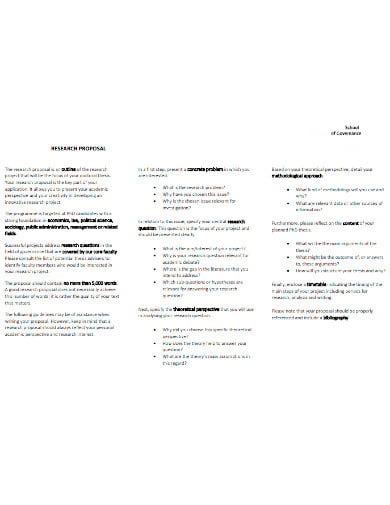
Pre-Proposal
Solicited proposal, renewal and continuation proposals, limited submissions, revised budgets, more in proposal templates, july 4th certificate, business school certificate template, transport and logistics cargo insurance certificate template, printable good behaviour certificate template, school cash management policy template, simple certificate of achievement template, world climate certificate, climate change certificate, easter certificate, spring certificate template.
- Proposal Templates – 170+ Free Word, PDF, Format Download!
- 57+ Training Proposal Templates in PDF | Google Docs | MS Word | Pages
- 7+ Logistics Proposal Templates in PDF
- 13+ Recruitment Proposal Templates in Google Docs | MS Word | Pages | PDF | MS Excel
- 12+ Logistics Business Proposal Templates in PDF
- 67+ Project Proposal in PDF , Docs
- 39+ Sponsorship Proposal Templates – Free Word, Excel, PDF Format Download!
- 23+ Funding Proposal Templates – DOC, PDF, Excel, Apple Pages, Google Docs
- 22+ Bid Proposal Templates – Word, PDF, Google Docs, Apple Pages
- 16+ School Project Proposal Templates – Word, PDF
- 11+ Product Business Proposal Templates – Sample, Example
- 10+ Travel Insurance Document Templates in Google Docs | Google Sheets | Excel | Word | Numbers | Pages | PDF
- 10+ Longevity Insurance Document Templates in Google Docs | Word | Pages | PDF
- 10+ Auto Insurance Templates in Google Docs | Word | Pages | PDF
- 10+ Homeowners Insurance Templates in Google Docs | Word | Pages | PDF
File Formats
Word templates, google docs templates, excel templates, powerpoint templates, google sheets templates, google slides templates, pdf templates, publisher templates, psd templates, indesign templates, illustrator templates, pages templates, keynote templates, numbers templates, outlook templates.
- Free Samples
- Premium Essays
- Editing Services Editing Proofreading Rewriting
- Extra Tools Essay Topic Generator Thesis Generator Citation Generator GPA Calculator Study Guides Donate Paper
- Essay Writing Help
- About Us About Us Testimonials FAQ
- High School Research Proposal
- Samples List
An research proposal examples on high school is a prosaic composition of a small volume and free composition, expressing individual impressions and thoughts on a specific occasion or issue and obviously not claiming a definitive or exhaustive interpretation of the subject.
Some signs of high school research proposal:
- the presence of a specific topic or question. A work devoted to the analysis of a wide range of problems in biology, by definition, cannot be performed in the genre of high school research proposal topic.
- The research proposal expresses individual impressions and thoughts on a specific occasion or issue, in this case, on high school and does not knowingly pretend to a definitive or exhaustive interpretation of the subject.
- As a rule, an essay suggests a new, subjectively colored word about something, such a work may have a philosophical, historical, biographical, journalistic, literary, critical, popular scientific or purely fiction character.
- in the content of an research proposal samples on high school , first of all, the author’s personality is assessed - his worldview, thoughts and feelings.
The goal of an research proposal in high school is to develop such skills as independent creative thinking and writing out your own thoughts.
Writing an research proposal is extremely useful, because it allows the author to learn to clearly and correctly formulate thoughts, structure information, use basic concepts, highlight causal relationships, illustrate experience with relevant examples, and substantiate his conclusions.
- Studentshare
- Research Proposal
Examples List on High School Research Proposal
- TERMS & CONDITIONS
- PRIVACY POLICY
- COOKIES POLICY
Got any suggestions?
We want to hear from you! Send us a message and help improve Slidesgo
Top searches
Trending searches
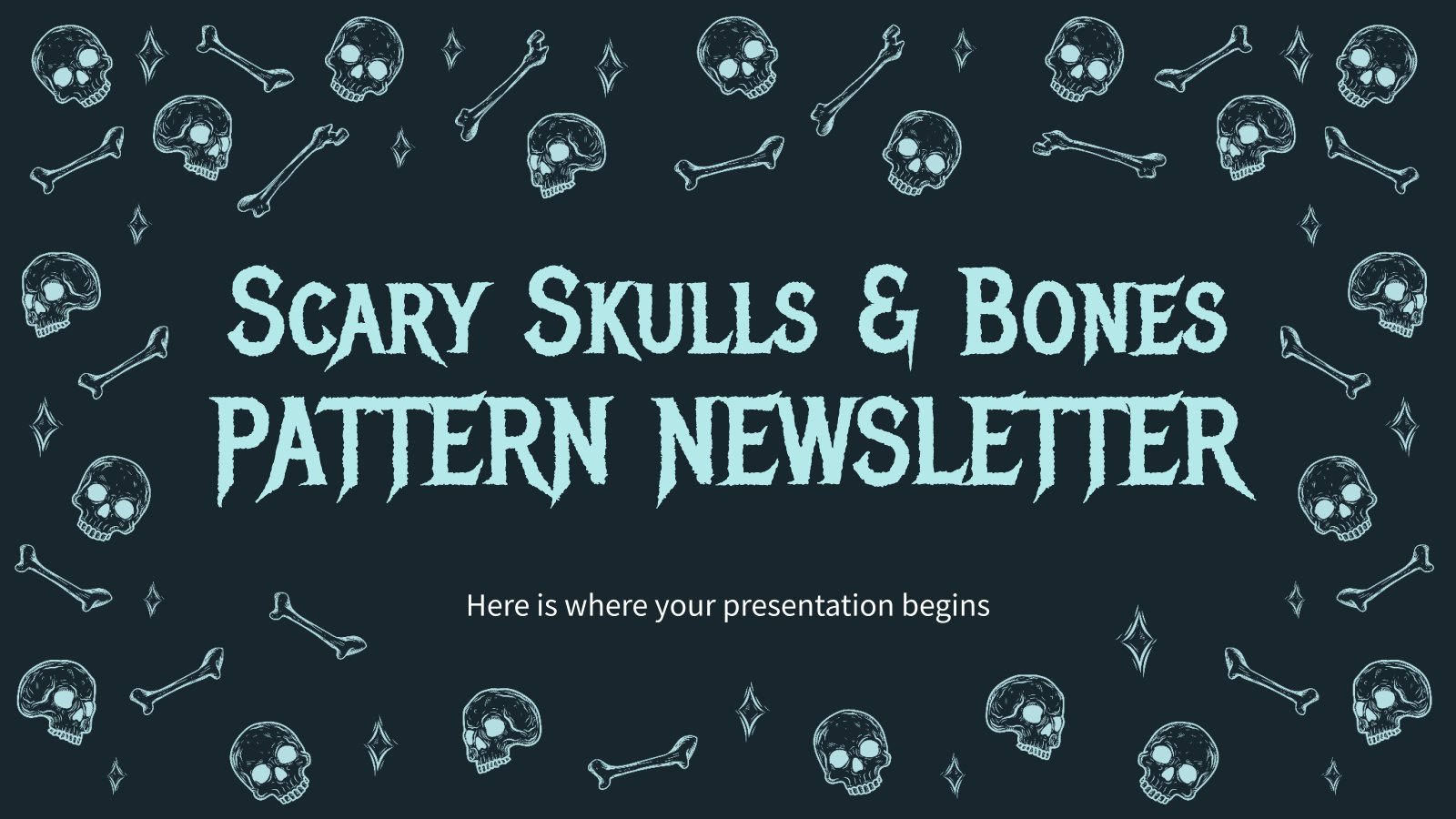
frankenstein
22 templates

el salvador
32 templates

summer vacation
19 templates
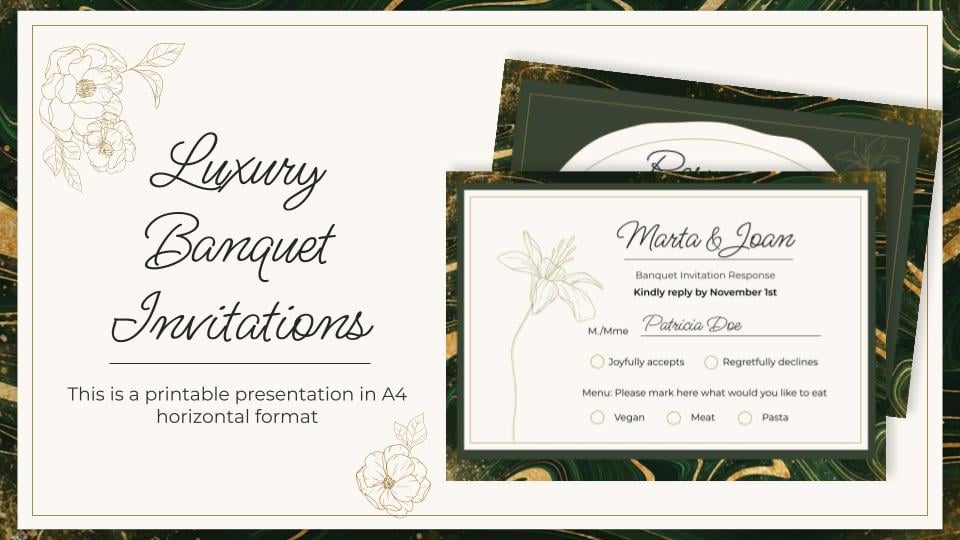
44 templates

17 templates

pediatrician
27 templates
Research Presentation templates
Customize our free themes and templates for google slides or powerpoint and explain what your research is about. these designs are easy to edit, so that will speed things up.
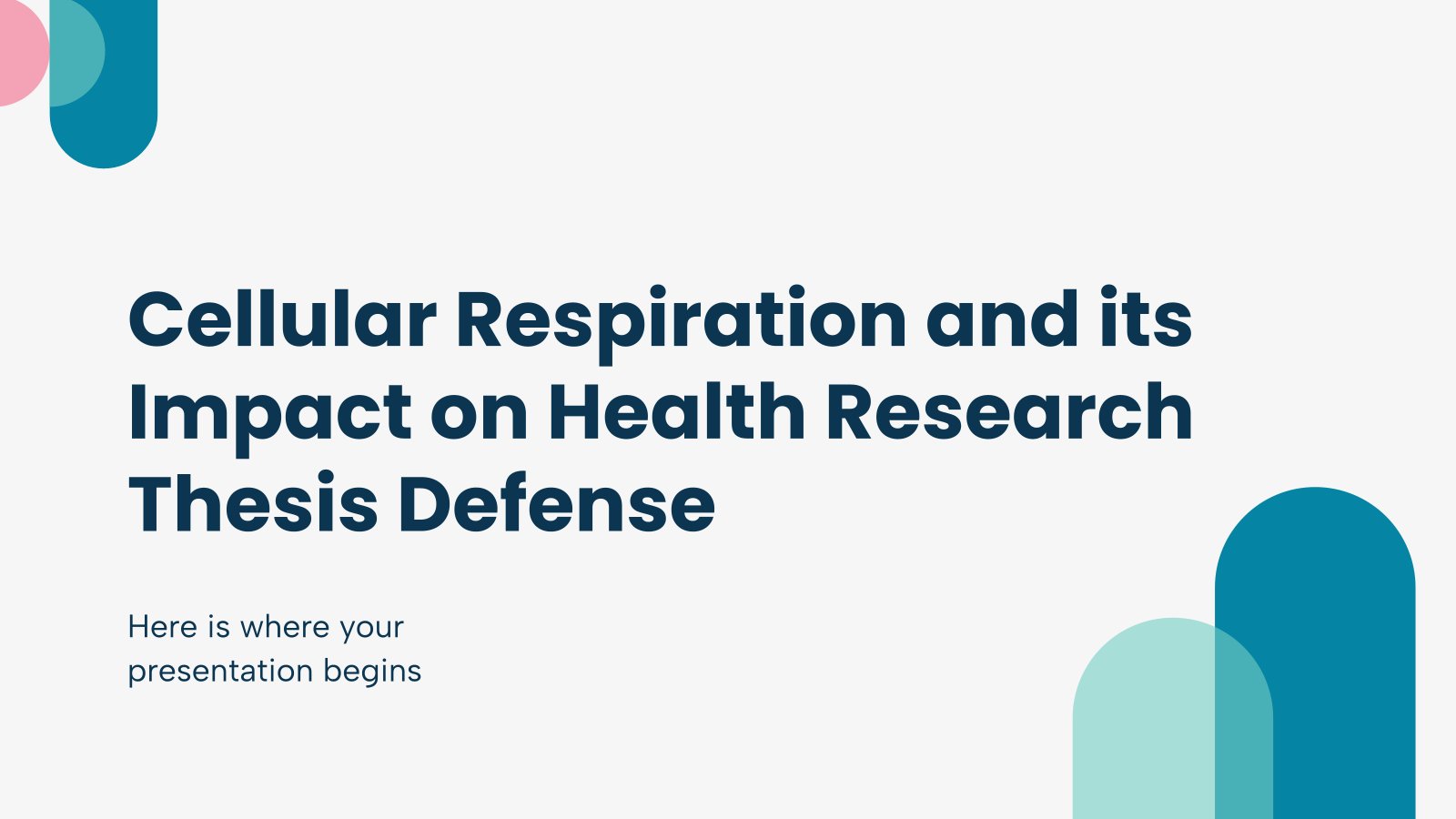
Cellular Respiration and its Impact on Health Research Thesis Defense
Download the "Cellular Respiration and its Impact on Health Research Thesis Defense" presentation for PowerPoint or Google Slides. Congratulations, you have finally finished your research and made it to the end of your thesis! But now comes the big moment: the thesis defense. You want to make sure you showcase...

Formal Research Paper Slideshow
Have you seen these slides? They are perfect for presenting your research paper! First of all, because we have included all the necessary sections of this type of work, such as hypothesis, objectives, methodology, analysis and the conclusions of the paper. The second reason is that the formal style will...

Economics Thesis
If numbers, exchange rates, money and trading are your forte, odds are you’re already working on an economics thesis for your master’s degree. Defending your dissertation is the last step and the most difficult one, but Slidesgo can help you. Here’s our new free presentation template with a focus on...

AP Research Defense for High School
AP, or Advanced Placement, is a North American educational program that offers a rigorous course designed to challenge and prepare high school students for their future careers and academic pursuits. It requires students to conduct independent research, write a lengthy academic paper, and present their findings to a panel of...

Cycle Diagrams Theme for a Medical Breakthrough
Download the "Cycle Diagrams Theme for a Medical Breakthrough" presentation for PowerPoint or Google Slides.Treating diseases involves a lot of prior research and clinical trials. But whenever there’s a new discovery, a revolutionary finding that opens the door to new treatments, vaccines or ways to prevent illnesses, it’s great news....
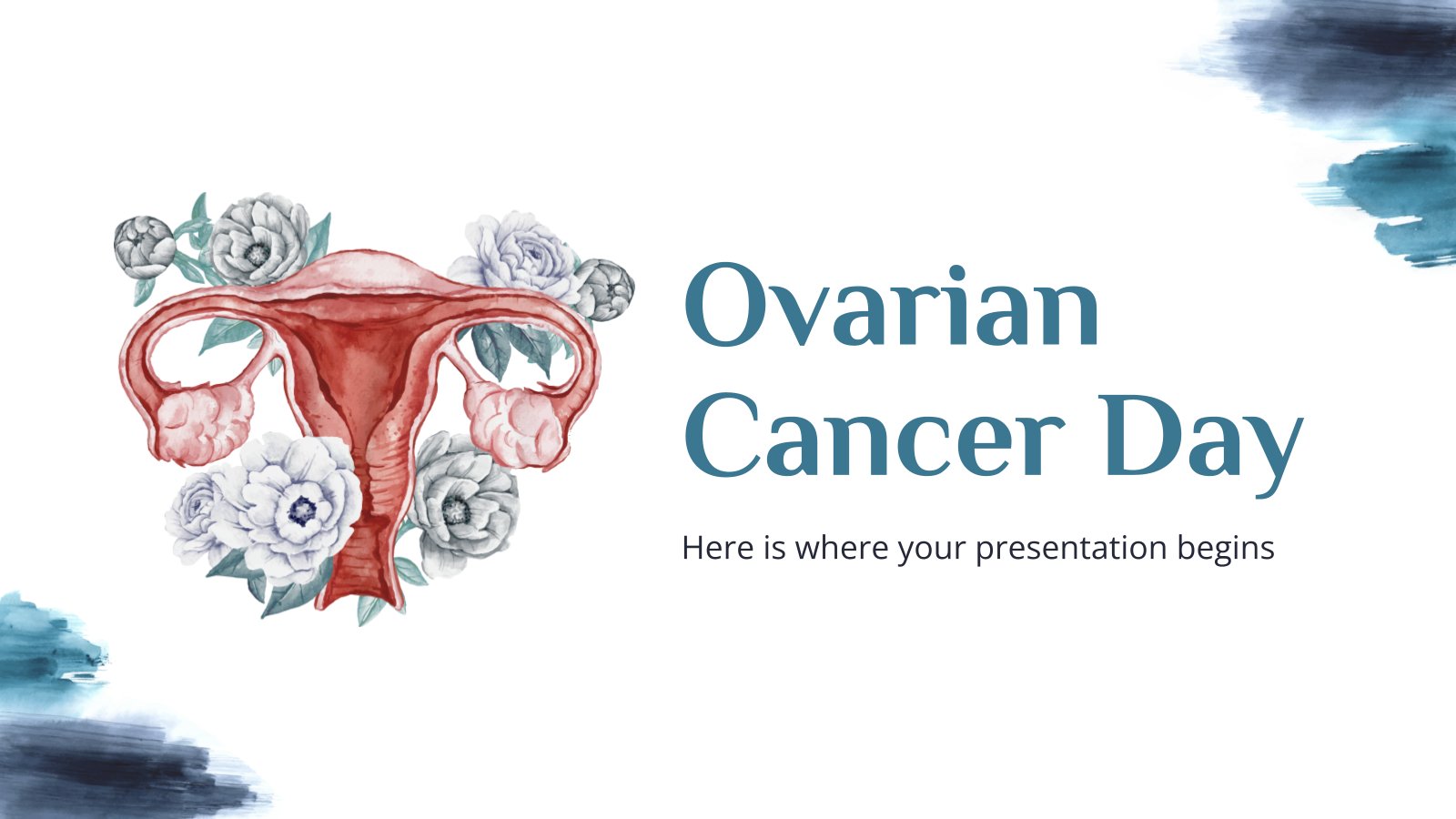
Ovarian Cancer Day
Download the "Ovarian Cancer Day" presentation for PowerPoint or Google Slides. Healthcare goes beyond curing patients and combating illnesses. Raising awareness about diseases, informing people about prevention methods, discussing some good practices, or even talking about a balanced diet—there are many topics related to medicine that you could be sharing...

Premium template
Unlock this template and gain unlimited access
Project Research Infographics
Download the "Project Research Infographics" template for PowerPoint or Google Slides and discover the power of infographics. An infographic resource gives you the ability to showcase your content in a more visual way, which will make it easier for your audience to understand your topic. Slidesgo infographics like this set...

Research Project Proposal
Before embarking yourself on a new project, especially if it’s about research, you need to set out a proposal to explain its viability. Here at Slidesgo we’re offering this theme that you can actually use for any kind of project, regardless of the topic.

Elegant Black & White Thesis Defense
Present your research findings with grace and assertiveness through this template. Available for Google Slides and PowerPoint, this design set offers minimalistic charm with its simple, gray scale elegance. The template not only provides a polished platform to showcase your thesis but also ensures seamless and efficient delivery of your...
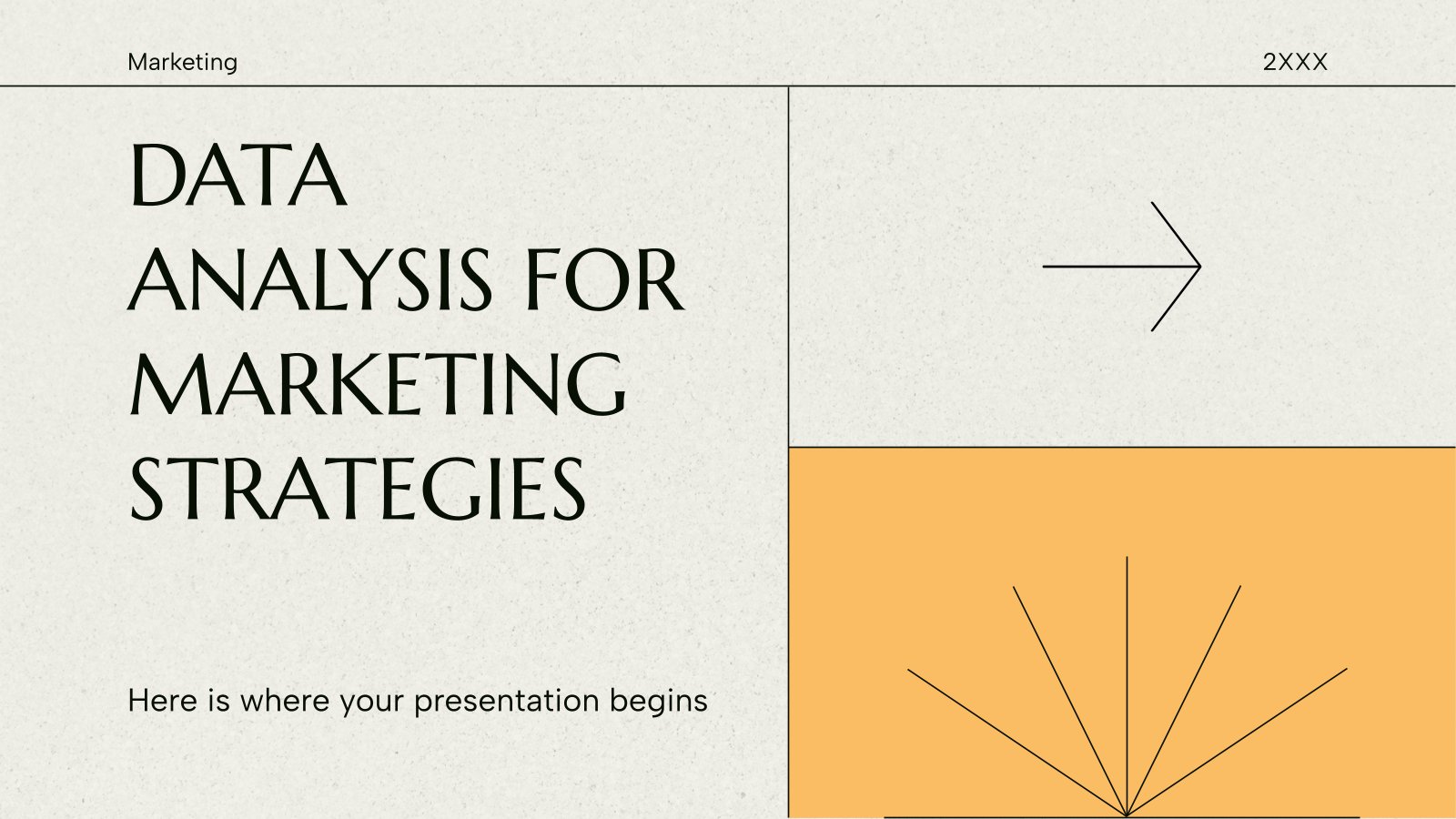
Data Analysis for Marketing Strategies
With the amount of data available through various digital platforms, it's easier than ever to determine the trends and preferences of your target audience. By collecting and analyzing data, marketers can create highly personalized campaigns that align with the exact needs and wants of their customers. If you're trying to...
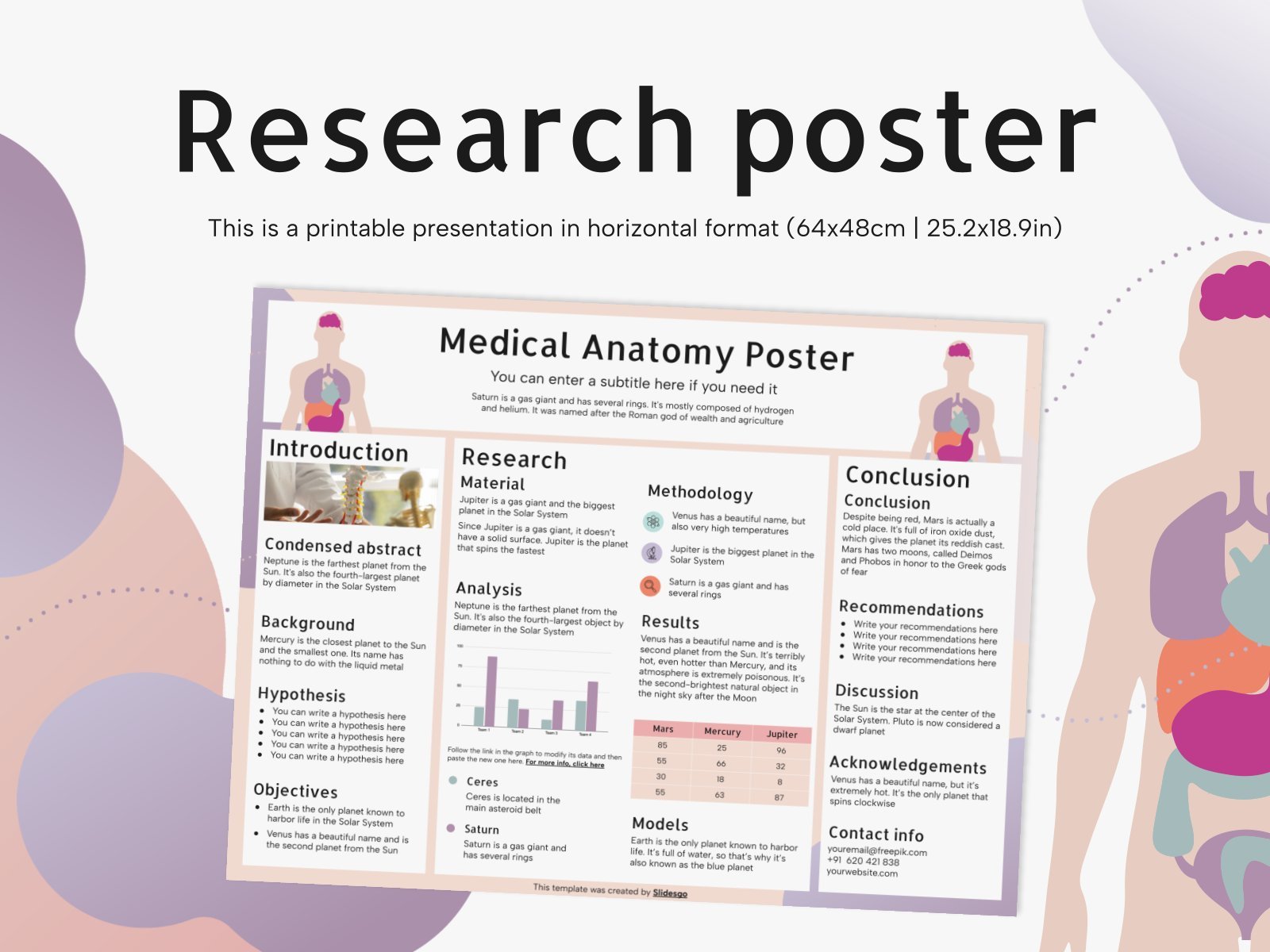
Medical Anatomy Poster
Download the "Medical Anatomy Poster" presentation for PowerPoint or Google Slides. Healthcare goes beyond curing patients and combating illnesses. Raising awareness about diseases, informing people about prevention methods, discussing some good practices, or even talking about a balanced diet—there are many topics related to medicine that you could be sharing...
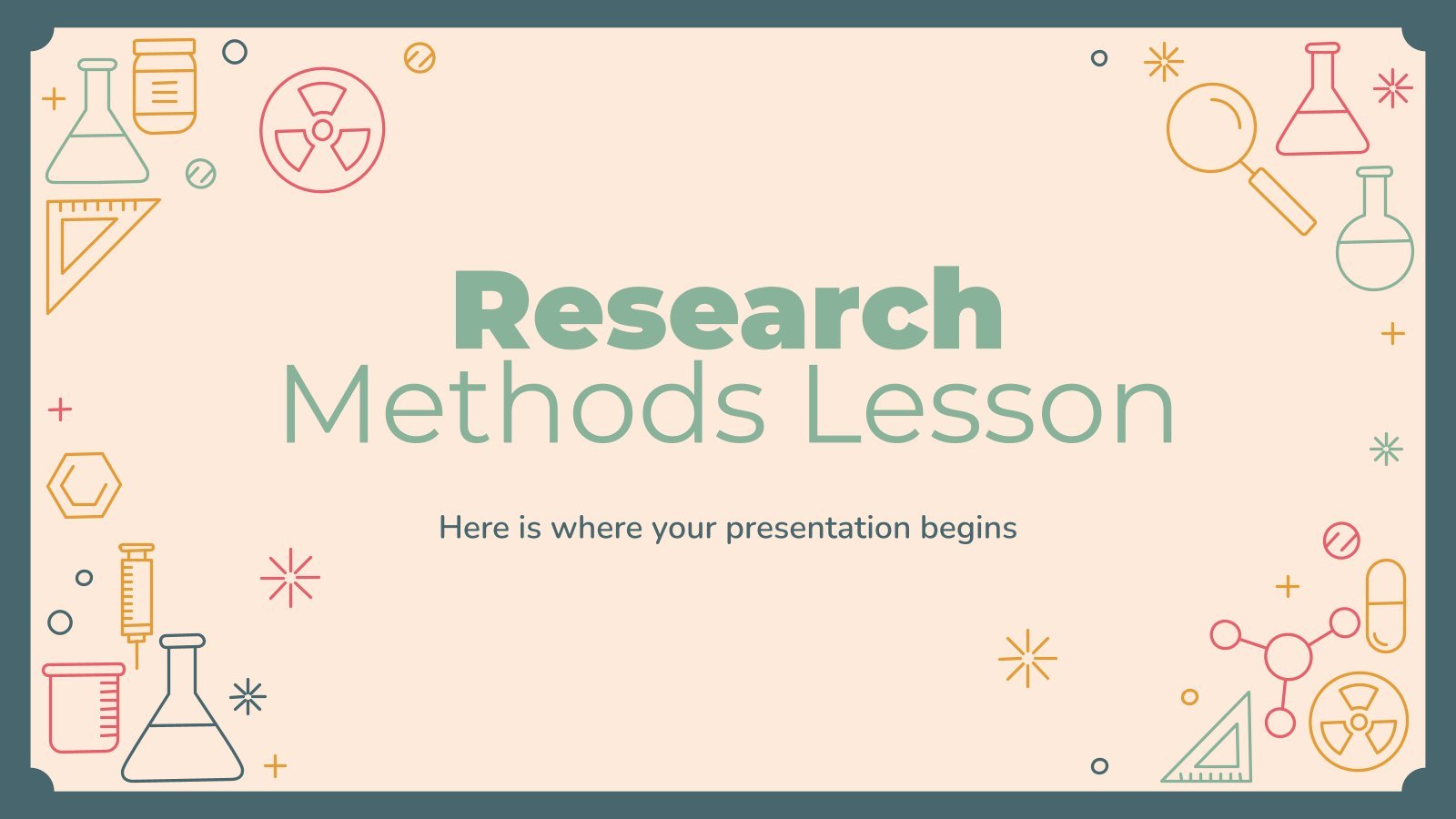
Research Methods Lesson
If you deal with Science, it’s important to learn more about research methods. Teach your students about them with this presentation full of illustrations and drawings related to labs. Use graphs, maps, tables and overview diagrams to support your lecture in a visual way!

Market Attractiveness Analysis
Download the "Market Attractiveness Analysis" presentation for PowerPoint or Google Slides and take your marketing projects to the next level. This template is the perfect ally for your advertising strategies, launch campaigns or report presentations. Customize your content with ease, highlight your ideas and captivate your audience with a professional...
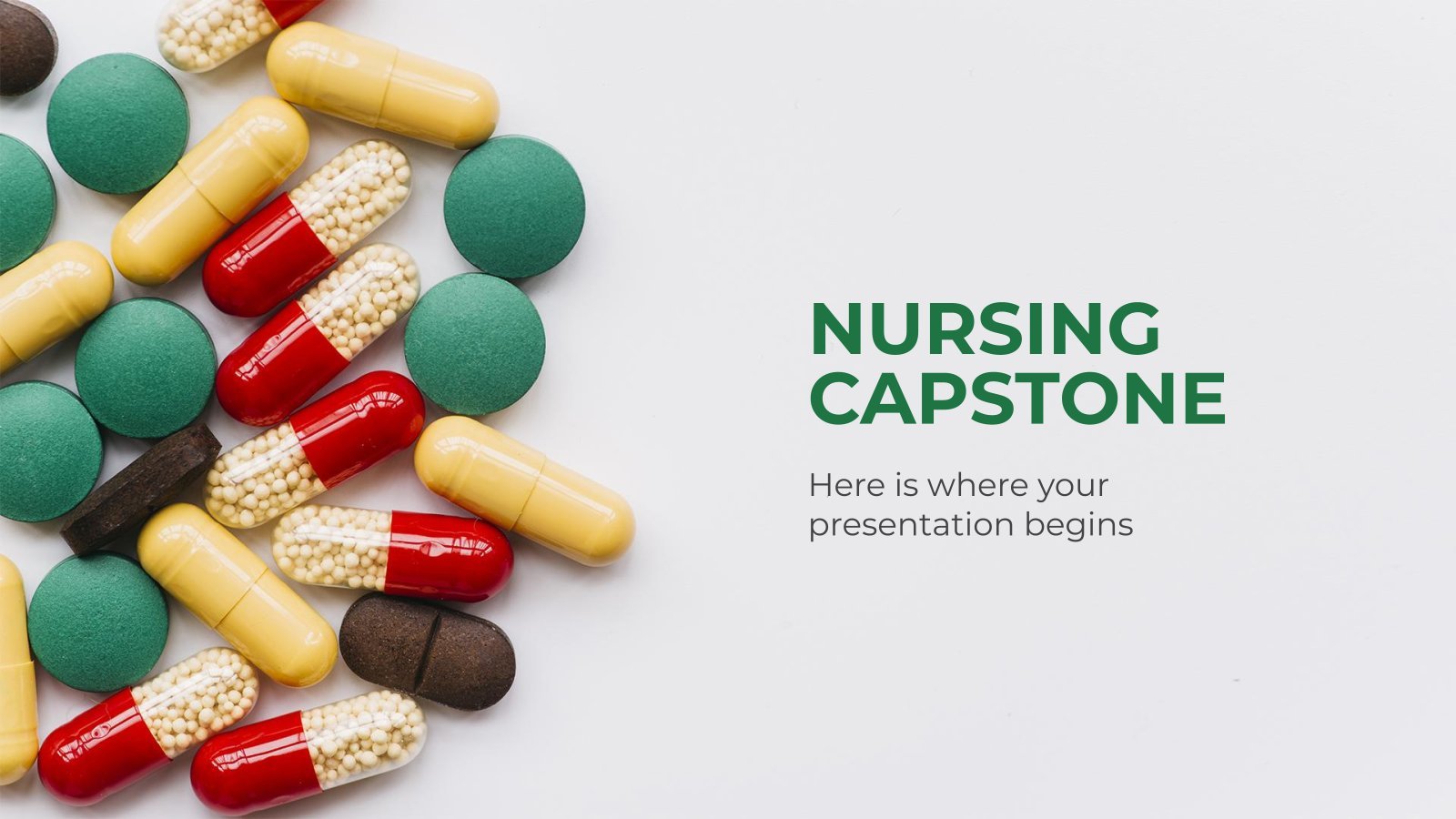
Nursing Capstone
In medical contexts, a capstone is often the final course in a nursing degree, a project of vital importance. It’s very demanding, so if you need help with the presentation, use this free professional template. Leave the design to us and focus on your data!

Trachea Regeneration Breakthrough
Download the "Trachea Regeneration Breakthrough" presentation for PowerPoint or Google Slides.Treating diseases involves a lot of prior research and clinical trials. But whenever there’s a new discovery, a revolutionary finding that opens the door to new treatments, vaccines or ways to prevent illnesses, it’s great news. Should there be a...

Pregnancy Breakthrough
Giving birth to a baby is a beautiful occasion, a manifestation of love between two people. Obstetrics are key during pregnancy, so how about giving a presentation about the latest breakthrough in this field? Our free medical template will come in handy.

Pneumonia Diagnosis Breakthrough
Download the "Pneumonia Diagnosis Breakthrough" presentation for PowerPoint or Google Slides.Treating diseases involves a lot of prior research and clinical trials. But whenever there’s a new discovery, a revolutionary finding that opens the door to new treatments, vaccines or ways to prevent illnesses, it’s great news. Should there be a...

SWOT Analysis Infographics
Discover the strengths, weaknesses, opportunities and threats of your own company performing a SWOT analysis. Use this basic strategic planning to evaluate your position with these new infographics created by Slidesgo.
- Page 1 of 80
New! Make quick presentations with AI
Slidesgo AI presentation maker puts the power of design and creativity in your hands, so you can effortlessly craft stunning slideshows in minutes.

Register for free and start editing online

COMMENTS
Research proposal examples. Writing a research proposal can be quite challenging, but a good starting point could be to look at some examples. We've included a few for you below. Example research proposal #1: "A Conceptual Framework for Scheduling Constraint Management" Example research proposal #2: "Medical Students as Mediators of ...
A well-structured research proposal includes a title page, abstract and table of contents, introduction, literature review, research design and methodology, contribution to knowledge, research schedule, timeline and budget. Visme's research proposal examples and templates offer a great starting point for creating engaging and well-structured ...
Here is an explanation of each step: 1. Title and Abstract. Choose a concise and descriptive title that reflects the essence of your research. Write an abstract summarizing your research question, objectives, methodology, and expected outcomes. It should provide a brief overview of your proposal. 2.
Detailed Walkthrough + Free Proposal Template. If you're getting started crafting your research proposal and are looking for a few examples of research proposals, you've come to the right place. In this video, we walk you through two successful (approved) research proposals, one for a Master's-level project, and one for a PhD-level ...
Step 4. Revise and rewrite the research question/hypothesis. Example: Purpose Statement (Declarative): The purpose of this study is to explore the association between 9/11/01 and future plans of high school seniors. Note: Both are neutral; they do not presume an association, either negative or positive.
Depending on the length of your research proposal, you may wish to include a contents page for the proposal itself (not for your main research project: suggested contents for this are included in your Proposed Chapter Outline, section 9), as follows (add page numbers/subsections when you know them, depending on your research).As you introduce sub-sections into your different sections, number ...
The research proposal template covers the following core elements: The cleanly-formatted Google Doc can be downloaded as a fully editable MS Word Document (DOCX format), so you can use it as-is or convert it to LaTeX. PS - if you'd like a high-level template for the entire thesis, you can we've got that too.
Revised on July 23, 2023. We have designed several free templates to help you get started on a variety of academic topics. These range from formatting your thesis or dissertation to writing a table of contents or a list of abbreviations. We also have templates for various citation styles, including APA (6 and 7), MLA, and Chicago.
Likewise, you can use the search bar to find a specific file type. Try "school project" or "business plan," and add the keyword "research proposal" to narrow your search. Once you find the right research proposal template for your needs, use Canva's free, online editor to easily plug in your content and personalize the file.
March 13, 2024. If you want to get into top universities, an independent research project will give your application the competitive edge it needs. Writing and publishing independent research during high school lets you demonstrate to top colleges and universities that you can deeply inquire into a topic, think critically, and produce original ...
Template 10: Research Project Time-frame for Academic Student Research Proposal. This is an actionable PPT Template that provides you with an in-depth timeline for any proposed research project. It contains milestones to mark key events during its course, weekly activities that illustrate various phases, and a map outlining all phases.
The Effects of Mindfulness-Based Interventions on Stress Reduction in College Students. Abstract: This research proposal examines the impact of mindfulness-based interventions on stress reduction among college students, using a pre-test/post-test experimental design with both quantitative and qualitative data collection methods. Introduction: College students face heightened stress levels ...
Research proposal examples. Writing a research proposal can be quite challenging, but a good starting point could be to look at some examples. We've included a few for you below. Example research proposal #1: 'A Conceptual Framework for Scheduling Constraint Management'.
Create a folder on your computer where you can store your electronic sources. Use an online bibliography creator such as Zotero, Easybib, or Noodletools to track sources and generate citations. You can read research papers by Polygence students under our Projects tab. You can also explore other opportunities for high school research.
A Research Proposal Template provides a structured outline for researchers to present their study ideas in a coherent and organized manner. Our team has thoughtfully crafted a template to simplify this process for you. You'll be delighted to know that our Research Proposal Template is now accessible in both Word and Google Docs formats.
Free Research Proposal On This Paper Addresses The Discrimination And That Students With A Latino Background. 1) Problem Statement. Regardless of the fact that the Hispanic population is one of the largest cultural groups in the country, it is still classified as one of the minority groups by the federal government.
To make a background research plan — a roadmap of the research questions you need to answer — follow these steps: Identify the keywords in the question for your science fair project. Brainstorm additional keywords and concepts. Use a table with the "question words" (why, how, who, what, when, where) to generate research questions from your ...
In 8th grade, we will conduct THEMATIC RESEARCH - that is research that is based on an overarching theme. Your goal is to create a 2 - 3 "magazine-type- page" academic essay that presents information and illustrations (pictures, charts, graphs, etc.) that supports your group's theme by exploring a specific topic within the theme.
Created: February 14, 2024. DPI: 300. Dimensions: 8.3 x 11.7 in. Google Fonts: Lato, Josefin Sans. Compatible with: Google Slides, Microsoft PowerPoint, MacOS Keynote. Use this template. Description. This Research Proposal Free Google Docs Template provides a structured format to articulate your ideas effectively. Designed to meet the needs of ...
FREE 10+ School Research Proposal Templates in PDF | MS Word. A thesis or research proposal is a document that presents a research project, usually in the sciences or engineering, which typically forms a funding offer for that work.Proposals are to be judged on the expense and possible effect of the planned study, and the soundness of the proposed plan for its execution.
In our online database you can find free High School Research Proposal work for every taste: thesis, essays, dissertations, assignments, research and term papers etc. - easy and free. Choose any document below and bravely use it as an example to make your own work perfect! Samples List. An research proposal examples on high school is a prosaic ...
Download the "Project Research Infographics" template for PowerPoint or Google Slides and discover the power of infographics. An infographic resource gives you the ability to showcase your content in a more visual way, which will make it easier for your audience to understand your topic. Slidesgo infographics like this set...